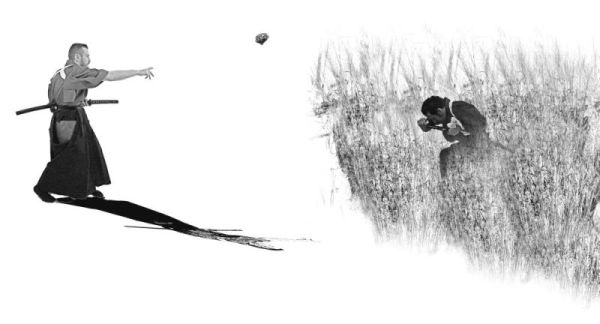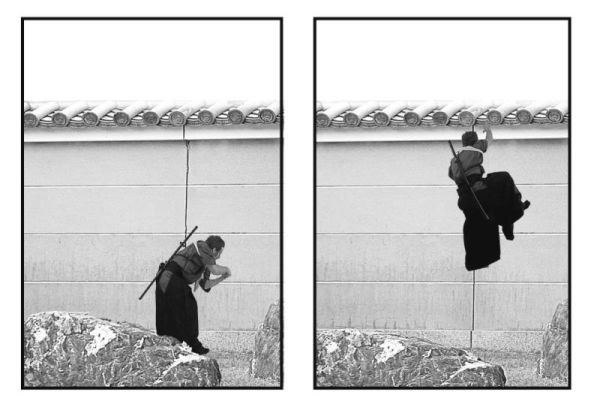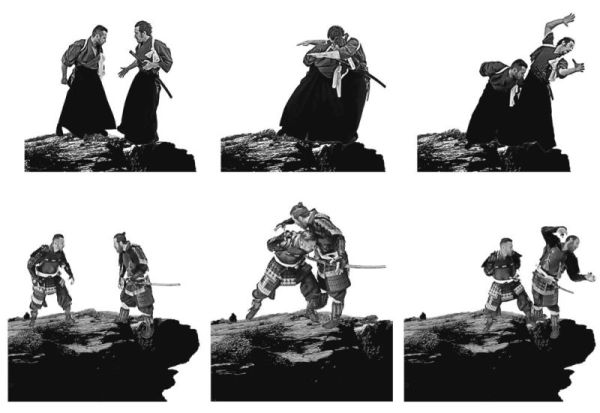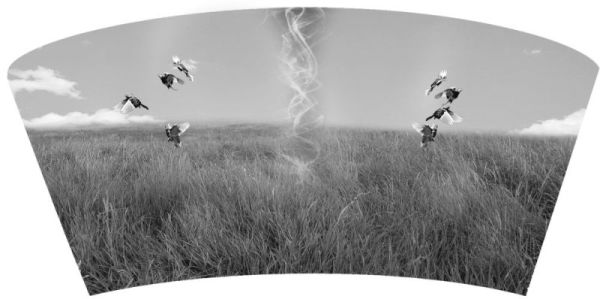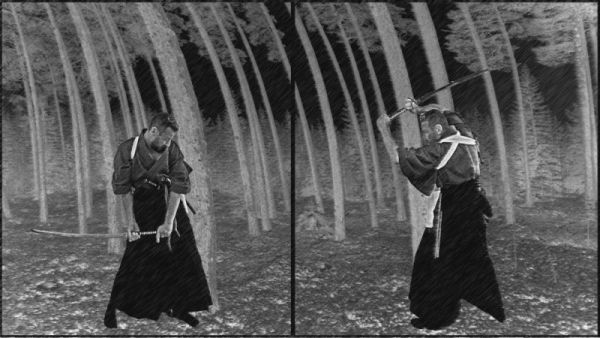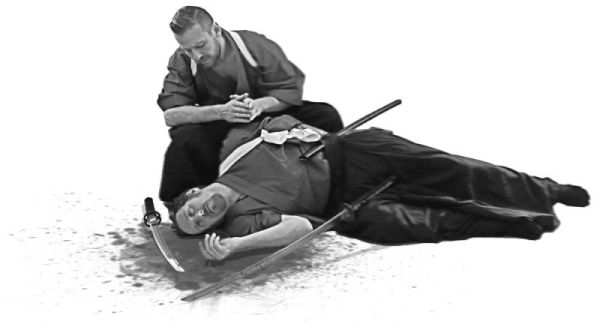14
DEEP SECRETS AND THE ARTS OF THE SHINOBI
Mubyōshi Ryū contains other elements outside hand-to-hand combat and weapon skill sets. These external elements, like their martial arts, are aimed at self-protection. Samurai skills can be divided into military and civilian arts, meaning some skills are required for military campaigns while other skills are used for self-protection in samurai civilian life. The latter is where the arts of the shinobi and the more esoteric skills join this school’s curriculum.
Hagiwara Jūzō himself points out that his school is not primarily a shinobi school, and that the path of the shinobi is not the task the people of the school perform. This means that they are not hired to perform as shinobi for their lord and do not engage in espionage or commando tactics, as that task would have mainly been done by the men in the lord’s employ who were from Iga and Kōka, or decedents of those warriors. The result is that this collection of shinobi skills, put together by Hagiwara Jūzō, concentrates on:
• home infiltration
• protection from infiltrators
• safe traveling
• personal vendetta skills
• escape after making a kill
• protection from spirits and other magical elements
The result is that the shinobi skills of Mubyōshi Ryū can be seen as specific to the students’ individual needs. This can be observed when compared to other schools that show a strong element of military shinobi skills. Therefore it can be stated with confidence that the Mubyōshi Ryū’s shinobi curriculum is almost fully focused on civilian life. To add to this, other deep secrets, including ritual magic, charms, and spells, are mixed in with these shinobi arts, crossing many elements together that help a practitioner defend against men or monsters in the night.
Some of the following scrolls clearly identify shinobi skills from other elements, dividing them from each other, while some scrolls provide an eclectic mix. Overall there is a clear image of a skill set that allows defense against intruders to the home, thieves while traveling, and monsters, which were believed to travel the dark roads of Japan at night. Hence, Mubyōshi Ryū is an exceptional example of the use of the shinobi arts in a time when military action was in rapid decline and a concentration on personal protection was emerging as a prominent feature in samurai life. This section comprises the following scrolls:
• Mizukagami: This is one of the better-known named shinobi scrolls in the ninja community, in both Japan and the West. Most likely originally written by Hagiwara Jūzō in the mid-1600s, the earliest known transcription is 1678, in the Cummins Collection. Multiple transcriptions exist in both private and library collections and more continue to appear on the market. Containing the core selection of shinobi skills and other survival tips, this scroll is the foundation of Mubyōshi Ryū’s ninja curriculum, for both offense and defense.
• Mizukagami Kuden no Oboe: Kuden is Japanese for “oral tradition.” This can consist of secret teachings or of those details too difficult to write down in full. It denotes the passing on of information by word of mouth. As time passed and information was not passed on so frequently, oral traditions were sometimes written down. In this case, the oral traditions that expand on the Mizukagami scroll were recorded here. Only a single version of this scroll is known to exist.
• Mizukagami Shinsatsu: Only a single transcription of this scroll has been found to date. Literally, the title means “a new volume of the Mizukagami.” the scroll revisits sections of the original Mizukagami, giving extra information and detail, but in addition adds multiple new skills. Written at a later date, it is unknown whether the new information contained within it was passed down by the original students of Hagiwara or if these are newer additional skill sets. Much of the information, however, can be seen in the Mubyōshi Ryū kuden list, meaning that those elements must indeed have been inherited from older days, but without a full transmission, it is difficult to assess the dates for each skill. As many do appear in the older kuden list, it can be assumed that these are original teachings. The most distinct difference between this scroll and the original Mizukagami is the obvious inclusion of a vastly higher percentage of magical skills, steering away from what we would consider practical and which start to fall outside the shinobi.
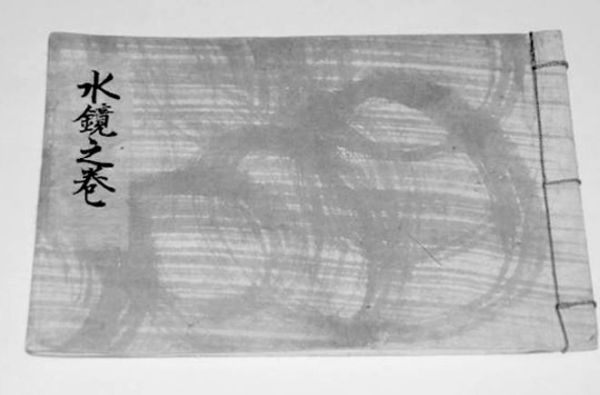
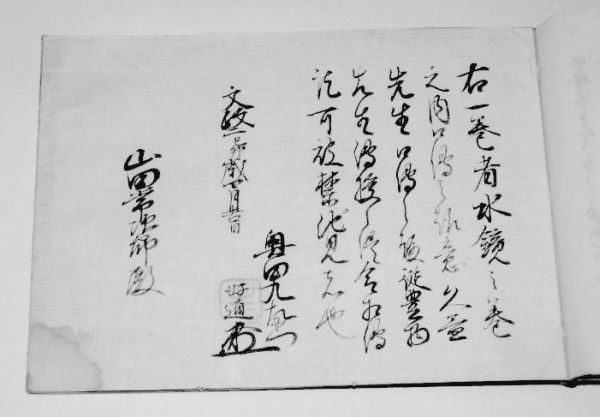
Figure 14.1. The Mizukagami on Yahoo Auction. Sadly I did not know this was for sale until after the transaction was finished.
The scrolls above account for this school’s ninja curriculum, but they also delve deep into magic. In Japan the arts of the shinobi also have a very solid section of magical elements, but here some of the spells and rituals included start to fall outside of the aim of shinobi no jutsu. Therefore there are parts that stand beyond the realm of the shinobi.
THE WATER MIRROR SCROLL (水鏡, MIZUKAGAMI)
Although there are various arts and skills for the bushi, most people are not aware that there are no other elements than flexible (柔), hard (剛), strong (強), and weak (弱), and that only a few people master this principle.
As naturally as water seeks its own level, even someone who has a formidable reputation can be killed if he lowers his guard. Be aware that disasters of all kinds are caused by a lack of vigilance. People tend to be inattentive when they feel too familiar with something and forget basic precautions. Therefore, in order to deal with such inattentiveness, I here record how to overcome an enemy instead of being overcome yourself, and for the prosperity of students to come in the future.
When you walk late at night in places where you feel insecure, you should carry stones in your sleeve that are of an appropriate size to hit someone with. Also, throw one of them into any place where you suspect danger. If anyone is there, they will surely reveal themselves.
When you cross over a river you are not familiar with, try to cross it diagonally upstream. Details are in the oral tradition.
When a storm is raging and you cannot see what is ahead of you, if you find something white or conspicuous anywhere on the ground, do not pick it up. If you do so without care, you will be marked1 and easily killed in most cases. [To see what it is,] draw your sword and check it with the scabbard, and then leave it there. Details are in the oral tradition.
If you come across mountain bandits, keep your mind calm and pass through as quickly as possible without becoming scared. While traveling for two or three ri (5–7 miles) from that point, keep a watchful eye for anyone coming from the front, rear, right, or left. Mountain bandits are usually in a group of six from the servant class.2 Know that only one will show himself at first while the other five or so will be hiding in a grassy field or somewhere of that nature. In some cases, one may pretend to be ill on the road and ask you if you have medicine. In that case, do not get close to such a person. Also, you should be suspicious if a stranger asks you to travel together in daytime. More details are in the oral tradition.
When you want to flee after killing someone at night and as quickly as possible, you may become disoriented and not know which way is east, west, south, or north. In this case you should try to find a stream and move upstream. It will surely lead you to a mountain.
Once you get onto the mountain, take a position at a high place so as to have a view of the landscape. That will allow you to find where the roads are situated. This is done to observe those chasing you with torches or lights. In this situation, you should think carefully [about your next step].
If they are about to come upon you, and if you are finding it difficult to continue to escape, cut off the tip of your scabbard so that you can breathe through the hole. To do this, submerge yourself in water holding your scabbard with the opening in your mouth. Stab your sword, shortsword, or knife onto the bed of the water and use it as an anchoring point. There is a certain way of breathing you need to learn. Details are in the oral tradition.
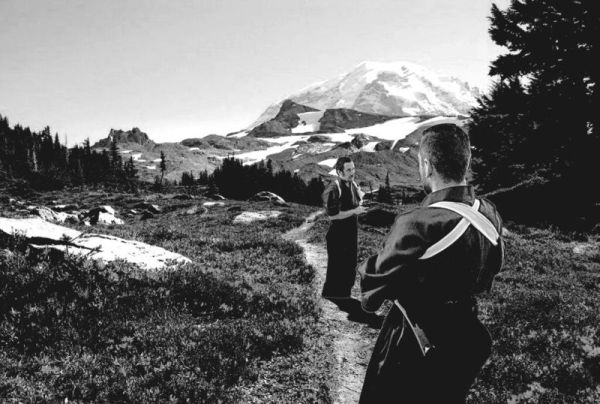
Figure 14.3.
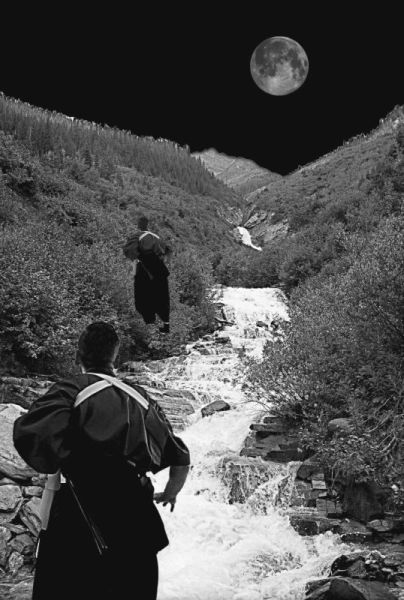
Figure 14.4.

Figure 14.5.
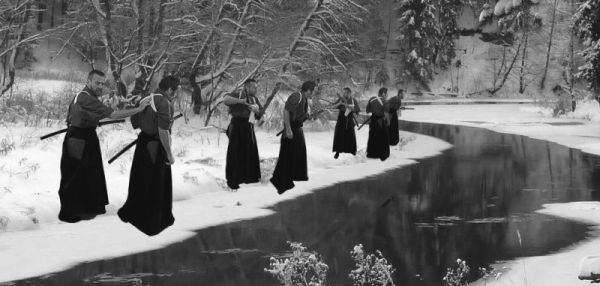
Figure 14.6.
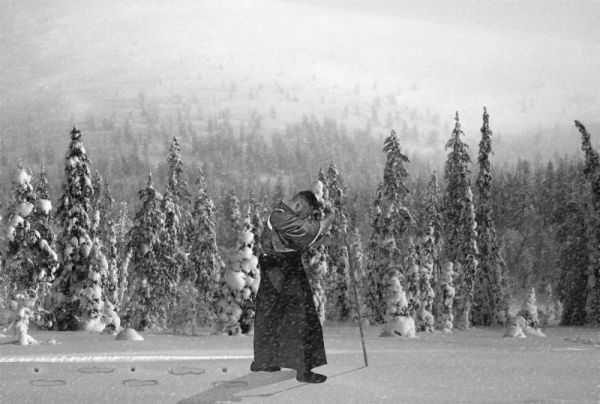
Figure 14.7.
Also if you are injured, it is good to walk in a stream to throw off your pursuers.3
If there is snow on the ground, put on your footwear on backward, use a cane on your left side, and walk into a stream. By doing this, your footsteps will be difficult to decipher.4
While traveling and staying at lodgings that you think are not secure, observe what the defenses are like at the rear of the house. This should be done in case a fire or robbery takes place. In a building, inspect the following:
• floor
• veranda
• ceiling
• tatami mats: where the mat springs under your inspection, you should check beneath by pulling it up.
In a bedroom, place your things where they are not safe while the light is on, and after the light has been doused, move your gear to where it is safe. Also, use a very uncomfortable pillow. There is a pillow called the Pillow of Crickets,5 and with it you will wake up even if a cricket comes into your room. If you have a mosquito net in the room, there are things you should be aware of on how to keep your swords at the ready. This is an oral tradition.6
You should secure the door by drilling into the ends of the doors. The drill should be made as in the drawing.

Figure 14.8.
This [drill] can also be used when you infiltrate a place where the doors or paper sliding doors are secured tightly, or when you need to climb up onto the roof in the event of a fire or a situation such as this.
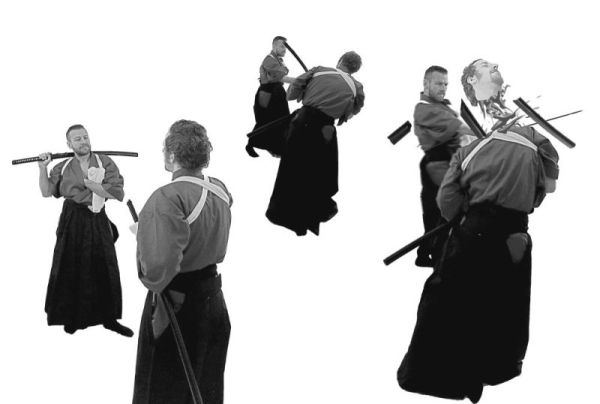
Figure 14.9.
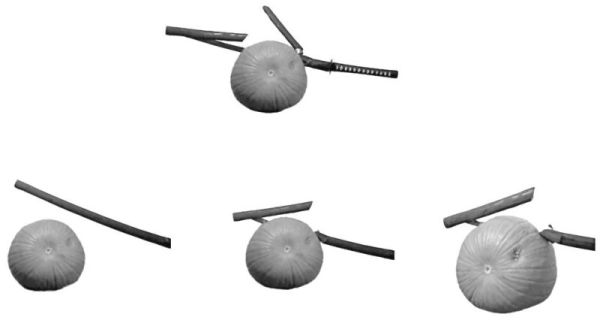
Figure 14.11. A paper scabbard sword cutting test. The cut was not made with extreme force but with a steady and natural swing to demonstrate its effectiveness.
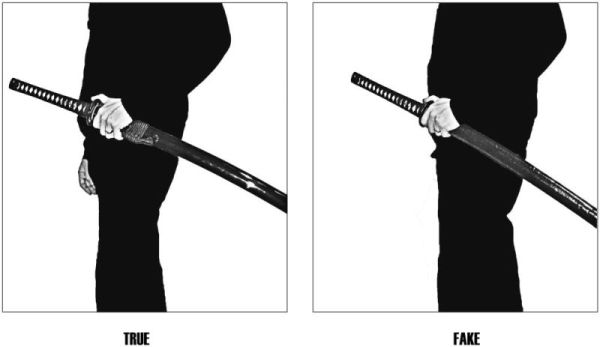
Figure 14.12. The scabbard on the left is made of wood; the one to the right is made of paper.
When you have [a servant] carry a lantern for you, it is not good to have him go ahead. Instead, have him on your left side about two or three shaku behind your swords.7 This is done so that you can get a good view of every direction: front, rear, left, and right.
If someone is approaching you in a relaxed manner with his left hand inside his kimono and his sword in an informal position, do not let your guard down, be it day or night.
If this happens at night, it is possible his sword is in a scabbard that is made of black paper and that he may immediately strike you with the sword without unsheathing it (fig. 14.9).8 There are more details for what you can do for this. There are five things you should keep in mind in the oral tradition.9
If it is daytime, he may hook his scabbard hook10 into his topknot and draw his sword with only with his right hand and then strike, keeping his left hand in his kimono (fig. 14.13).
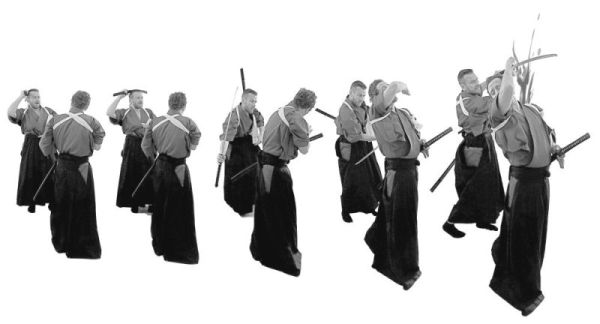
Figure 14.13.
If you pass by [an enemy] and put a distance of four or five chō (500–600 yards) between you, you may feel relieved and out of danger and consider that there are no more enemies in the area, and you may even talk to someone and let your guard down. Remember, if the man you are talking to strikes at you with a sword that is housed in a black paper scabbard and with correct timing, there will be no chance the strike will fail.
If you find someone has infiltrated your house and want to know [if someone around you] is the infiltrator, call out to him with your own name. This is an oral tradition.
If a large number of yatō (night thieves) enter your house, it is seriously inappropriate for you to strike up a light inside the building. If you have to defend against them in small number, and if you hear them whisper occasionally, if you wish to kill them, stretch rope in the direction where you expect they may come from. Do this at the height of four or five sun [5–6 inches].
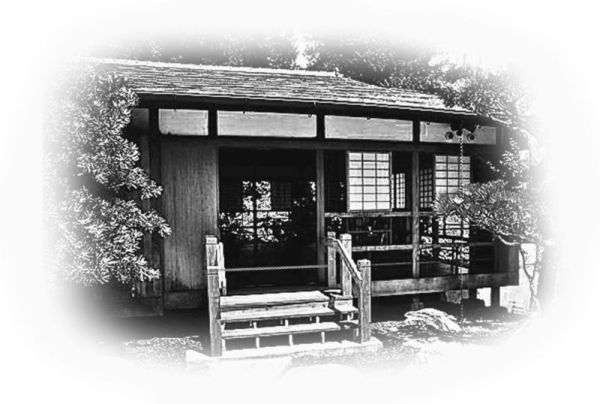
Figure 14.14.
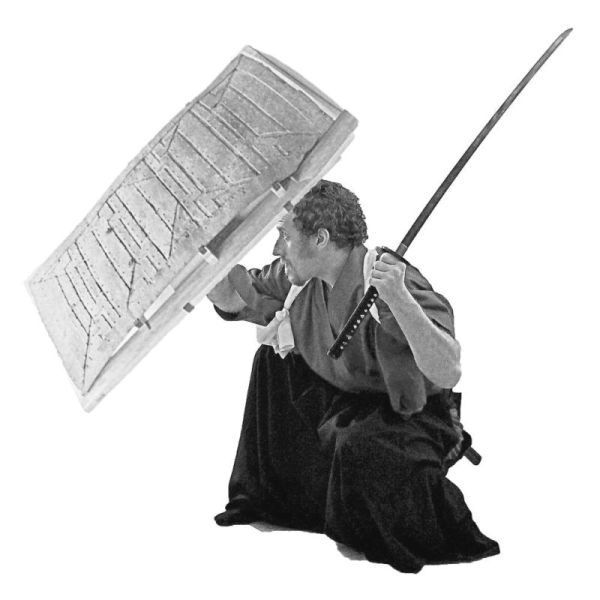
Figure 14.15.
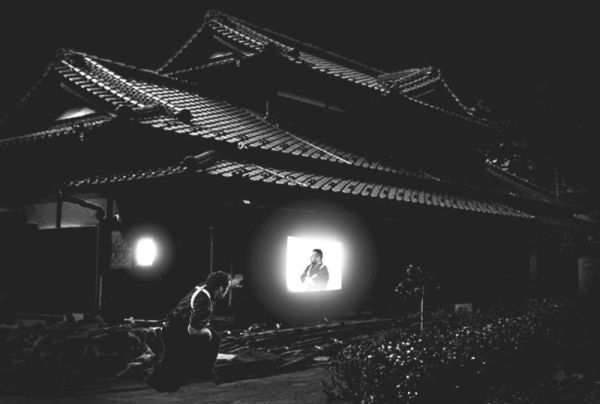
Figure 14.16.
Then while waiting for them, you should hold something you think will serve as a shield, and also hold your weapon diagonally, and sweep at them with this weapon.
Remember, if you make a light inside a room, those who are in the darkness outside can see you clearly, and thus it is a dire mistake. It is essential for shinobi to carry lights. More details are in the oral tradition. There are oral traditions when scattering caltrops on a night attack and also teachings on night attack tools.11
Even if you do not know when the enemy shinobi will actually come,12 it is more than likely that you will have a gut feeling concerning the matter. If you feel it appropriate, you should prepare for them. If the shinobi know that you have noticed [they are there], they may in response copy an animal’s call when they approach. Therefore, you should be aware of this and not think it is in fact an animal.
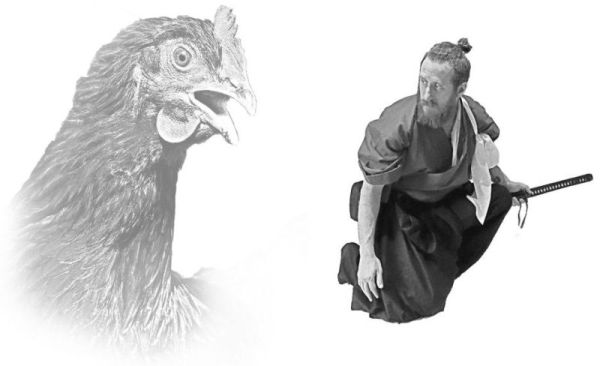
Figure 14.17.
Shinobi have various other techniques, more than just this one [concerning animal noises]. For example, if you hear someone cough at a distance, you should be aware he is close by you. [Shinobi] have a technique to make a cough sound like it is at a distance while actually the cough is very close.
If there is a moat, river, or pond, they sometimes may have prepared a stone of an appropriate size at the side of the water. They do this before they infiltrate. This is done so that if they are detected and chased, they will throw the stone into water [so it will sound like they have escaped that way]. You should be aware of this and not be deceived by such a trick. More details are in an oral tradition.

Figure 14.18.
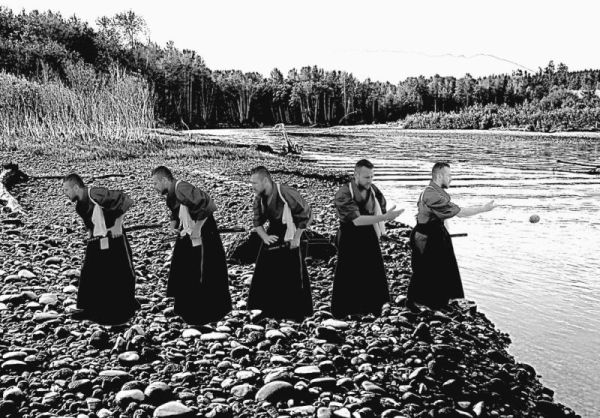
Figure 14.19.
If you need to search the house for shinobi13 who have infiltrated the building, draw your sword with only two or three sun [2–3 inches] of the blade left inside the scabbard. Also, have the scabbard cord stretched out and attached onto your obi belt. Hold something as a shield with your left hand to protect yourself while searching.
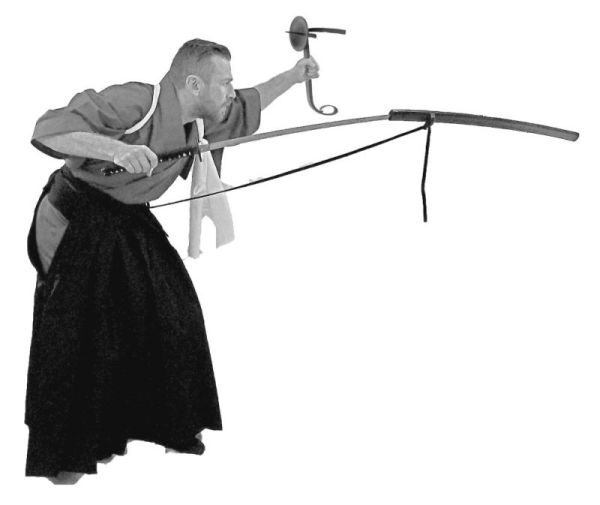
Figure 14.20.
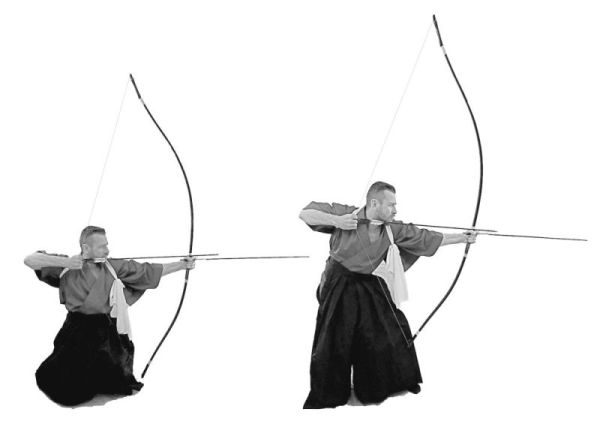
Figure 14.21.
You can also search with a bow too. To do this, draw the bowstring tight and hold it. Next, hold a second arrow14 with the left hand, grasping the rear of the shaft with the fingers, search around with the arrowhead. However, it is not easy to search closely because [the arrow] hits here and there [as you move around the room].
If the shinobi [no] mono realizes you are searching for him, he may be crouching in the fire and hearth, keeping himself composed, waiting to take advantage of any chance to escape. Hiding in a hearth is effective because people defending a position are very familiar with the hearth and its position, so it is very likely that they will just pass by it as they usually do. Be warned: if you get close to the hearth to get a light and without care, you may be struck.

Figure 14.22.
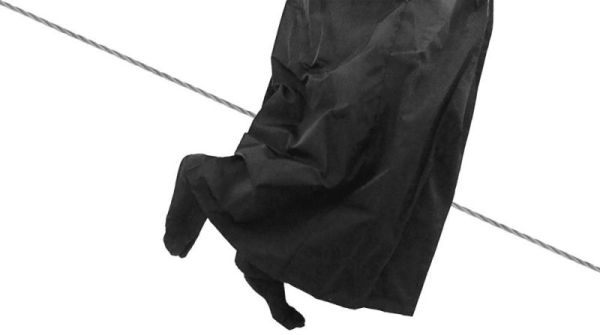
Figure 14.23.
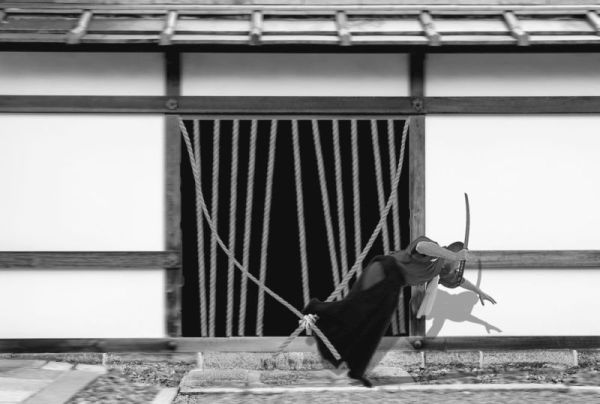
Figure 14.24.
When you pursue [someone who has infiltrated], it is essential for you to pay attention to everything. If the infiltrator is careful enough, he might have made arrangements such as [the following two points]:
He may stretch a thin rope across the exit at the height of four or five sun [5–6 inches].
He may cut a door curtain15 into vertical strips as with a rope curtain,16 leaving only four or five sun [5–6 inches] [uncut] at the bottom. Also, he may tie up the cords of the two ends of a rope curtain.
Also, he may crouch below steps, if any, and when you step down, he may attack you with the sword. You should be careful about these techniques.
If chased all of sudden, [shinobi] may scatter caltrops as they retreat. If you step on the caltrops, you cannot pursue him, and you will not be able to take even another step.
When they exit out a gate, they will close the doors17 behind them. This is so it will take you time to open it. Meanwhile they gain about five ken [100 feet] in distance in the time it takes you to open the door. There are things you should learn, whether as a pursuer or if you are being chased. These are oral traditions.
When you are walking and all is normal, if you are called from behind and attacked with a sword, there is a certain way you should draw your own sword. Also, there is a technique to stop such an attacker without even drawing your sword. This is an oral tradition.
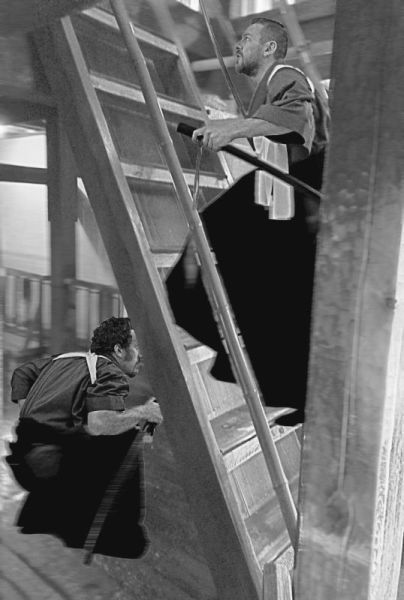
Figure 14.25.
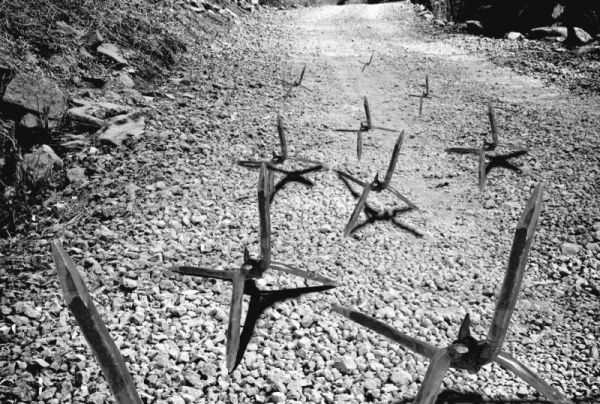
Figure 14.26.

Figure 14.27.
You should make a strong request of a shinobi, asking him to teach you to copy animal or bird calls. The technique is often useful when on a covert activity. In ancient China, at the checkpoint of Hangu Pass, the guards let Lord Mengchang go through the checkpoint since the guards thought that the crow of a cockerel that a retainer of the lord copied was real.18 Especially when you infiltrate on a night of kōshin,19 copying a cock-crow is a method used. Some people say; “What you do on a kōshin night will be discovered without fail.” This proverb seems to be a saying first spoken by thieves. [However, it is also said that] what is done on a kōshin night will not be discovered as easily as on a normal night.
When crossing a wall on a covert infiltration, stand your sword against the wall, and tie the end of the sword cord around your ankle. Next, step on the hilt and hold on to a bracket [above you]. [When you are on top of the wall], retrieve your sword and put it back on your waist, then descend to the ground [on the other side].
If it is difficult to hold a bracket because the wall is too high, use the drill that you are carrying and insert it into the wall so that you can [reach up and] cross over.
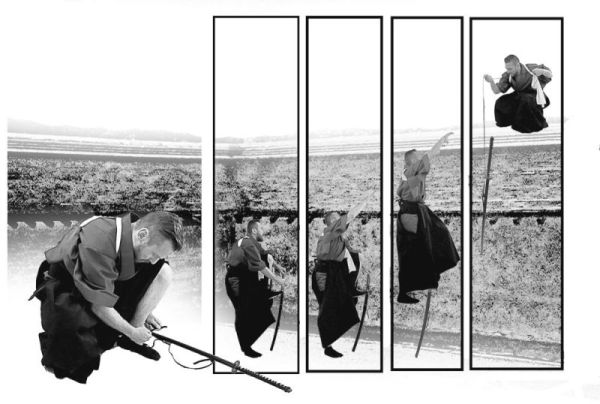
Figure 14.28.
Alternatively, use a grappling hook.20 Generally, when the wall is high and difficult to cross, you should put [the rope of] the grappling hook through your obi at your back with a two-shaku [24-inch] gap from the end of the hook, put the rope across the shoulder, and tie it onto your obi on the front, then cross the wall. Once you get hold of the bracket, you can hook the grappling hook onto it so that you can use your body freely.
It is commonly known that when descending, you should keep calm and put the grappling hook at an appropriate place, and then descend, holding the rope.
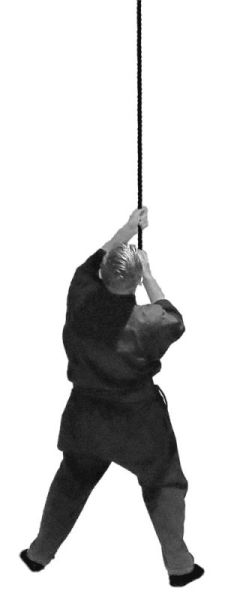
Figure 14.30.
Another way to descend is to use a drill as a handhold, descend holding on to it, and then letting go with one hand. Pay attention to your feet, swing out, and jump down lightly, then have the mental feeling of jumping again when you get to three shaku [3 feet] from the ground.
[When you land], you should intentionally move into a forward roll two or three times, one after the other, instead of landing directly on your feet. It is never proper to jump from a point that is too high. If you are going to jump, then you often become mitsuri with the heavier part in your top half and lighter in the lower part of your body. In this case you will hit [the ground] badly; there is no doubt about this. Even if you do not know of these teachings, it is best to concentrate on descending.
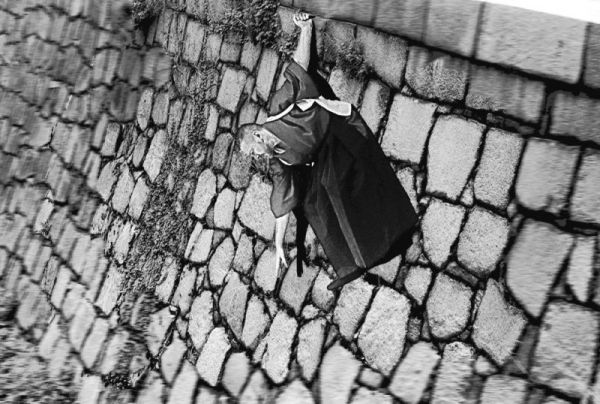
Figure 14.31.
Also, consider the quarterstaff useful [when descending21].

Figure 14.32.
Those who are knowledgeable in these things tend not to hurt themselves badly. There are various things to be orally transmitted on how to practice these points. There are other teachings on how to jump from a height. To jump from the height of two or three jō [20–30 feet] is an oral tradition.22
If the horse you are riding does not want to get on board a ship, dismount from the horse, trace the character for moon (月) on the horse’s bit, and then follow up with the character 賦 in the middle of the horse’s forehead.
賦
When you trace this character, hold the horse’s mouth with your left hand, trace the last dot in the direction of the ship, and say “hai” to the horse.
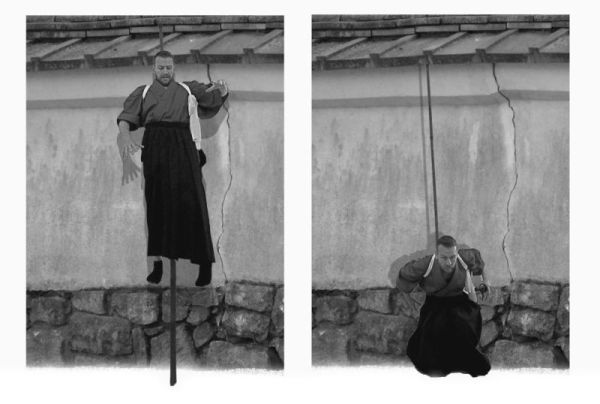
Figure 14.33.
If there is an unexpected argument and those present in the room are against you,23 or you have to deal with a large number gathering at night and you are in a room and alone with no one at your side to help, then, because you are vastly outnumbered, you may feel that you cannot defeat all of them, even if your own life is spent in the process. It is difficult for you to do anything outside the path of the bushi.24 Therefore, you may not able to decide what to do immediately. In this situation, keep calm, determine to die, and try to make your body in and your inside [mind] yō.25 Observe with exactness what the room is like, and fight with tactics.
Approach the light with a calm attitude and without attracting their attention. With correct timing, when you think it is the moment to do so, stand up, grab your sword, and kick out the light with your foot. If the light is a candle,26 put it out by taking out the wick. Also, you should use the candle stand as a shield to defend yourself with. Take shelter behind something that you have observed beforehand and stay still, keeping yourself as quiet as possible, and attack with full force only when appropriate and in accordance with the situation—attack from behind cover.
In any case, you should hold your tachi greatsword diagonally and sweep with it horizontally. Pay attention to all exits. Finally, if you take these above measures, even if there are many formidable people, they may lose all the advantages that they had and may even fight among themselves because of the darkness. Take advantage of these opportunities. Without doubt they will be of aid to you.
If there are three people talking in a room and two of them start arguing and then fighting with swords, you should intervene as follows: draw your wakizashi shortsword and hold it toward the one who seems the most determined, paying attention so that the blade will not turn away,27 and hold the scabbard in your left hand. Then take a position about two shaku [2 feet] away from the middle of the two of them and keep an eye on both. At the moment they attack each other with swords, try to divide them by flicking up their swords.28
If you cannot divide them, after warning them, strike between the wrist and the elbow so that they will drop [their weapons]. It is essential to inform them that you intend to divide them before you draw out your shortsword. It is also good if you raise a tatami mat from the floor and put it between them, or even to stand a sliding door between them. You should not try to talk about who is right or not concerning the argument. If you try to convince them by talking [about blame] and then draw your shortsword, you will surely be taken as assisting one of them and may possibly be attacked. If you can, it is better to stop them without drawing your sword. These techniques should be left to your judgement and will change according to the situation.
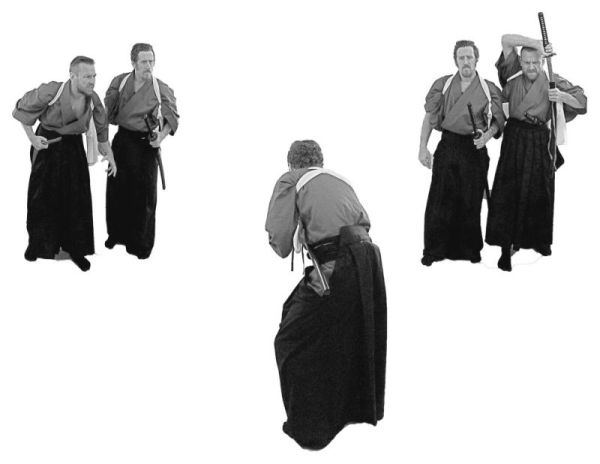
Figure 14.34.
When you serve as a second, assisting someone who is performing seppuku ritual suicide, do as follows:
Position yourself about two shaku to the left of the person who is going to commit seppuku with your swords at the waist. It is essential for you to observe the status of the person. If he looks like he is having regrets about committing seppuku, behead him just as he takes hold of the shortsword. If he looks determined, decapitate him when you see him cut his belly and when his neck straightens.
When he stabs his stomach with the sword and finish cutting, his neck will always tilt to the side. Remember, if you behead him when the head is tilted like this, then you will fail to [decapitate] properly. Make sure to do it when you see his neck positioned straight and upright. However, also remember that, if you concentrate too much on timing, thinking that you have to cut as soon as the neck is in that position, then it will also be inappropriate due to overconcentration. Just do it when you are spirited29 and when it feels right. Furthermore, you can draw your sword beforehand without being seen by the person who is going to perform seppuku and place it where it is convenient for use.
When the time comes, take a position on the left side of the victim, and at the appropriate time, move your right foot forward so that it is in line with his hip joint. Raise your big toe [from the ground] and point it up and in line with the earlobe of the person committing seppuku. In your mind, imagine cutting from the base of his topknot into the chest. Keep your waist low, and move onto the tip of your right big toe as you cut off the head with one stroke. Do this with double the intensely you can normally muster. You will not fail to cut the head off if you follow this trajectory.
If you do fail to take the head off in one strike, calm yourself, [turn the handle] and grasp your sword with the blade facing upward, and then cut the head off from the front at the throat, and do so without delay.
When someone is forced to kill himself, be very careful and get as close to the person as you can, so that you are almost approaching his right side [even though you are still positioned on the left], then decapitate him with your shortsword [instead of your longsword].
In this situation, you should draw your shortsword before the [ritual] starts and place it on the back of your left hand, and do not take your attention away from the victim performing seppuku. If the victim has hidden intent in his mind and makes a counterattack, do not retreat but instead immediately stab him with your shortsword with the intent to kill. If he commits seppuku without incident, then behead him in the same way as described above.
If you feel apprehensive but do not know the reason why, do not venture out, even if a close friend offers to accompany you. This is because if your life is in serious danger, you will have a sense of gloom—this will happen without exception.
In such a case, feel your pulse. Do this by placing your right hand on your throat pulse and your left hand on the pulse on your right wrist. If they are in the same rhythm, there is no serious danger.
If you are going to kill someone, you should first be determined to die and think nothing of yourself but only of the enemy. The enemy may be determined and vigilant and can readily give himself to any change in accordance to the four ways:30
1. flexible (柔)
2. weak (弱)
3. hard (剛)
4. brave (勇)
If this is the case, then know that this is a serious matter. In such a situation you should kill him by employing tactics. The enemy will also plan against you; therefore it is difficult to determine a single way to proceed. For both sides, there are two ways, known as sen-go:
1. sen (先), preemptive
2. go (後), responsive
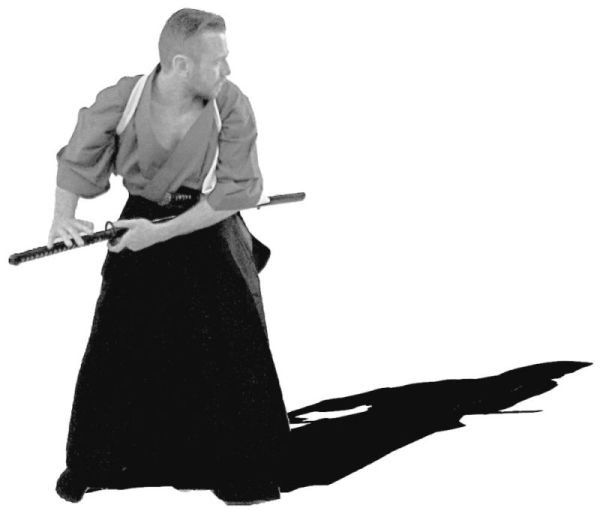
Figure 14.35.

Figure 14.36.
There are various and numerous tactics that can be undertaken by those who have mastered themselves well and have settled and stabilized their nerves. These [tactics will change] according to what the enemy residence is like, or what the surroundings are like, and so on; everything cannot be explained here. However, the following is an example:
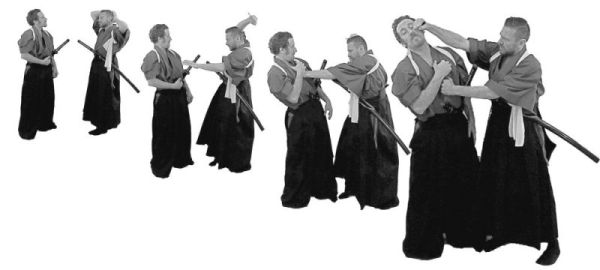
Figure 14.37.
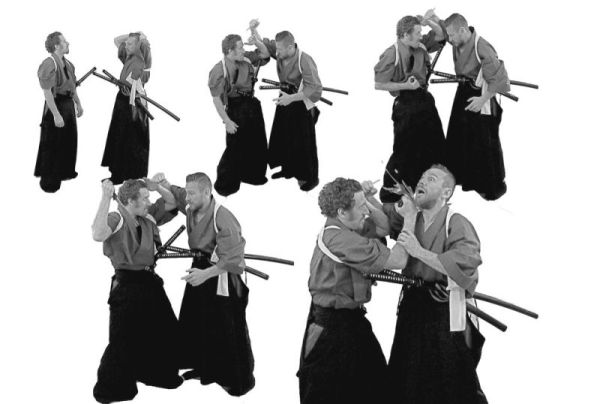
Figure 14.38.
Realizing you are coming, he may pretend to be ill and defenseless, having no swords, wearing a tenugui cloth for an obi sash. He may approach in this defenseless way, preparing his hair and holding a paper string in his mouth.31 In such a case, he will have hidden a bladed weapon in his hair, and he will attack you by taking advantage of any gap you leave open. He will concentrate on striking straight down with both hands,32 landing the blow on the forehead. In this he will not fail. This is because he has opted to take the preemptive move.
Therefore, be aware that in this situation, there may or may not be a way to respond. Simply walk toward him without preplanning, make sure it is not too fast but also not too slow, striding up to him steadily and without hesitation. This gives him the opportunity to kill you, so take the advantage of that moment and kill him instead. It is essential to force the enemy to move to an attack that will result in his own death.
This scroll has a small amount of writing concerning shinobi; however, we are not specialized on this matter.33 If you have a strong enemy that you wish to attack but he is too strong to overcome, and if you are going to conduct a night attack by yourself, you should do so by considering and planning with the above points. If you are determined and ready to die and have prepared with such tactics, then, when you attack, there is no way you will fail to fulfill your aim, no matter how strong the enemy is.
As I have said previously, you should not use these arts in an unrighteous way, and as you have given an oath, I need not make sure of [your intentions] again. However, if you use any of the above for unrighteous purposes, then be warned that you will not able to escape from the punishments brought on you by the gods.
The above scroll is a secret writing; however, as you are enthusiastic and wish to inherit these teachings, I will give it to you now. Take note: you should train yourself earnestly and without negligence.
[The collective names of all those who appear on the multiple transcriptions of this scroll:]
Niki Shinjūrō Masanaga (二木新十郎政長) [This name only appears on one version; in other versions Hagiwara Jūzō is given prime position if he is listed.]
Hagiwara Jūzō Shigetatsu (萩原重蔵茂辰), 1678
Tōmi Gen’nai Nobuna (東美源内宣名)
Kitagawa Kin’emon (北川金右衛門)
Igarashi Kin’emon (五十嵐金右衛門), 1678
Hattori Tokuzaemon Takenori (服部徳左衛門武順), 1797
Horii Shinji (堀井信二), 1797
Ikegami Yōsuke Hisamasu (池上用助久益)
Nagayama Sagozaemon Toyomotsu (永山佐五左衛門豊物)
Okuda Kuzaemon Yoshimichi (奥田九左衛門好道)
Yamada Tsunejirō (山田常次朗), 1819
Izumida Teikyūsai Gento (泉田貞久齊元渡), 1830
Yanase Kihei Yoshitomo (柳瀬喜兵衛義知)
Ishimaru Yatarō (石丸弥太郎), 1848
Morita Kohei (森田小兵衛), 1859
[The following two names are found in the Issō Mutai Ryū version of the scroll:]
Ōta Kiyozō (大田清臓)
Kubota Kazue (窪田數衛)
Comments on the Oral Traditions for the Mizukagami Scroll (水鏡口傳之覚, Mizukagami Kuden no Oboe)
[This text is divided in to three subsections.]
When you are going to cross over a river that you are not familiar with, estimate where the shallows are and judge the area to discern the point you should cross from, then cross upstream of this shallow area. To cross, move upstream of the shallows and cross in a diagonal fashion, and then when you are in the middle of the river, change to moving downstream and cross to the other side.
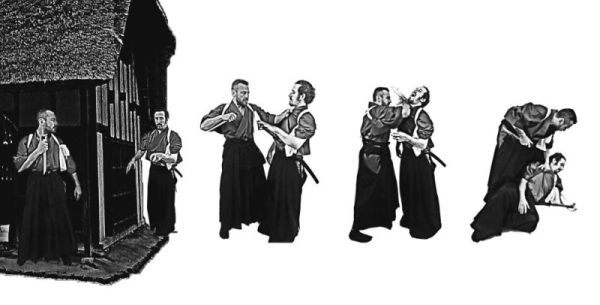
Figure 14.39.
At night when it is raining and you cannot see where you are heading, if there is something white or anything strange on the ground, pull out your sword, loosening the sword slightly from the scabbard, place it under the object, move it by flipping it over, and then pick it up. It is often the case that you may be killed because of such an object.
Hints for dealing with mountain bandits.34 It is essential to pay attention to everything as taught in writings [on such matters]. Samurai are sometimes found to be without a master and wander from place to place, which is not their wish, but it is required. As that which is martial is that which they do, and if there is no other way that [a samurai] can go, they will become yamadachi (mountain-bandits). If there is anyone available, then work together as a group to achieve this.35 If alone, have a shortsword of eight sun [9.5 inches] in length that is double edged and with no hand guard.36 This is to be used as a dagger that is kept inside the kimono. Next, wait at an appropriate place for someone to come by, grab the person by the chest, hold the dagger in the right hand in a reverse grip, and quickly cut his throat. Put aka inside the kimono.37 If someone else happens to pass by, keep the mind calm and say that this man was suddenly ill and that he has been given medicine, and that they should not worry, but just continue on ahead. When no one is around, throw the body from a cliff or somewhere where no one will see it. There are more details that are to be passed on in oral form.
The art of the cricket pillow38 (邯鄲の枕の事, kantan no makura no koto)
The image is an important aspect to be used in your sleeping quarters and should be transmitted from person to person in front of an altar. When you are in a traveling lodge, perform this method by meditating on the image of a rope that is surrounding the room. To perform this method, trace the characters (in fig. 14.40) with reference to the four directions and the center, then trace the arrow [seen in the image] toward the character for dog (犬). Place this under your pillow. Details on how to perform this are an oral tradition.
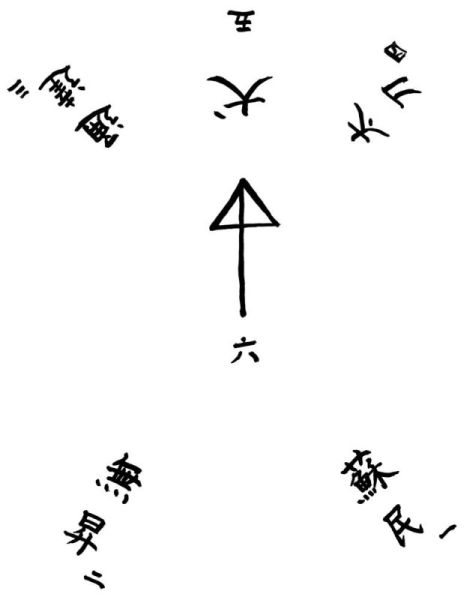
Figure 14.40.

Figure 14.42.
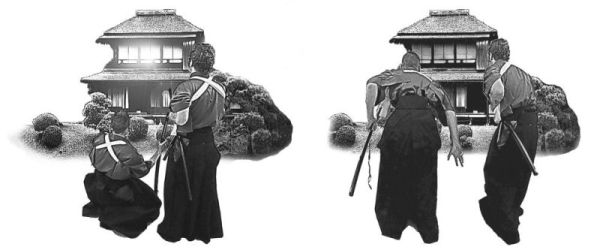
Figure 14.43.
When sleeping outdoors, again meditate on the image of a rope that is surrounding you. No matter how many chō or ri the distance is, the most important element is to have a strong image in mind. There are more oral traditions.39
When shinobi infiltrate your house, one of the things to keep in mind is the following point: You should call out with your own name, because if you call out to him using one of your retainer’s names, a shinobi no mono will be able to deal with this and answer, pretending to be that person. Therefore, you should call out your own name, and if the person answers as you, he must be an intruder.
When a number of shinobi infiltrate, the first thing to do is to make the inside of your house unseen from the outside. Put anything you can find over the lantern(s) so that those outside cannot see the inside. There are many details to consider.
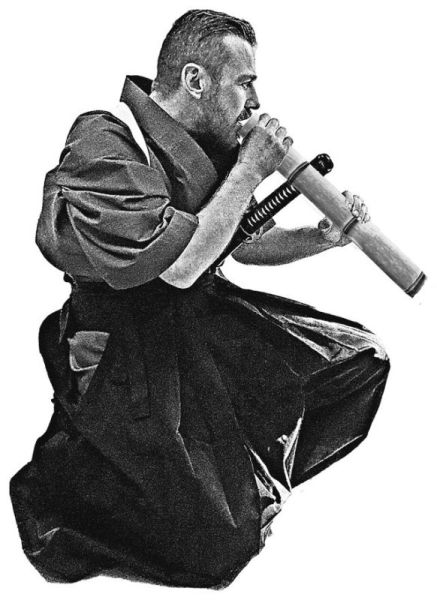
Figure 14.44.
The method of how a shinobi coughs: they sometimes cough with a bamboo cylinder at their mouths. There are other ways to do this, but they are oral traditions.
When you are chasing someone to kill him, and when the distance between you is about six shaku [6 feet] and you are still out of reach with your katana, dive forward and swipe at his legs. This is called nedake no kenmon.40

Figure 14.45.
When you are being chased by someone, if you intend to move into a small alleyway, you need to have enough distance between you [and the enemy], and then get in quickly.
How to defend against someone who is attacking from an alleyway with a tachi greatsword: when you cannot draw your own sword [in time], move to the left and make a turn. Next, stop his strike with your left hand by pulling out your katana while still in the sheath.41
When a father and son or brothers or close friends are arguing with others, if you have tried to settle the disturbance with reason, but neither of them are convinced to do so, both may become more violent. If you are in close proximity to your comrade, pretend not to pay any attention but place your hand behind [and hold the scabbard with this hand] and break the seal between the sword and the scabbard.42
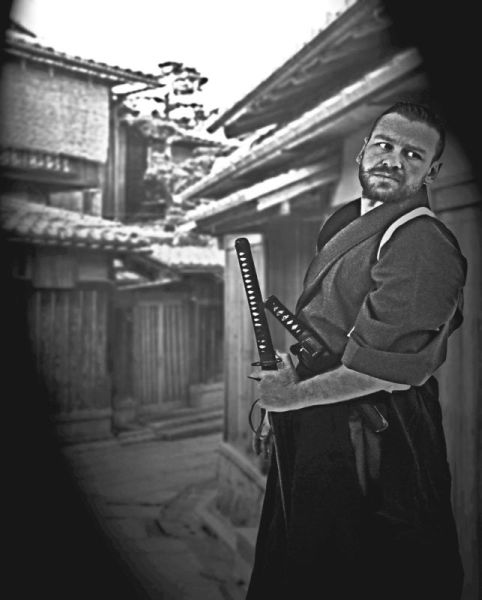
Figure 14.46.
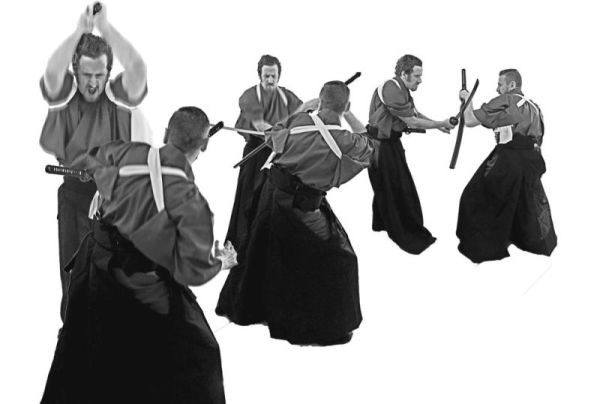
Figure 14.47.
If you are near the opponent, turn the blade inward.43 This will aid in advantage and disadvantage.
The above eleven points on how to use the Mizukagami scroll have been orally transmitted by Shigenao Sensei44 and written down here. Even though points concerning the Cricket Pillow have been written down, they should be taught at an altar, and that is why the details have not been given in full.
Comments on Elements of Mubyōshi Ryū’s Combat Skills (戦場組打無拍子流中通覚, Senjō Kumiuchi Mubyōshi Ryū Nakadōri Oboe)
Principles of the hidden dagger45 (懐剱之大事, kaiken no daiji46)
This is a hint for when you are in the presence of someone of high ranking. If you have an audience with [one of high rank] and desire to carry such a dagger, wear it between your inner and outer kimono. Have the blade pointing downward with the tip of the scabbard toward your thigh and the handle [upward] below your right armpit. When an emergency arises, you should take your kimono off your right shoulder and expose [your arm], draw the [blade], and stab. The hidden dagger is between nine sun, five bu and one shaku, two or three sun [11–15 inches] in length at its longest. It should have no hand guard.47 When things are urgent, you can [replace this] with your normal wakizashi shortsword. There is more to be orally transmitted.

Figure 14.48.
The surge of falling rocks and stones (岩石落之事, ganseki otoshi no koto)
When Lord Yoshitsune was successful in the assault on [the steep terrain of] Hiyodori,48 they collected many vines of the wisteria tree and braided a rope from them, then with branches they made folding ladders, and with these the army advanced. Where the horses could not walk freely, they bound their legs and carried them down where it was too difficult.
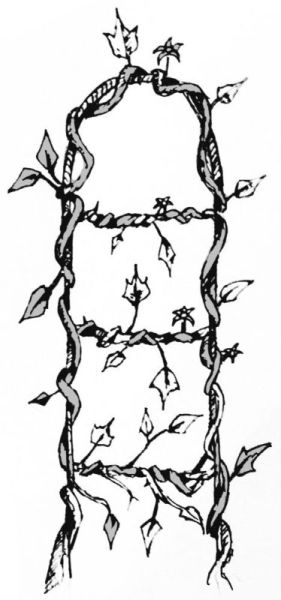
Figure 14.49.
Hints for things you should keep in mind for steep areas such as those given above:
In order not to be pushed down from such a high place [during combat], you should drop down with speed [keeping your center of gravity low]—this is an oral tradition.
If you intend to push someone off [a cliff], you should keep a good balance and put both hands on your waist and push him over with your shoulder. This is because if you try to push him off with your hands, the enemy may grab your hands and you will plummet together.
The secret skill of the many-petaled cherry blossom (極意八重桜之事, gokui yaezakura no koto)
[One record of this skill says chrysanthemum.49]
This is a secret for man-to-man combat on a battlefield. You should first decide which one of the enemy is your target, keep track of him, and have a good image in your mind. Then approach him gradually, consider the front tassets of his armor as cherry blossom petals and the strings of that section of armor the stamen of the flower. Drop down with your right knee on the ground and your left knee upward, and take hold of his tasset and lift it. During this, draw your sword with your right hand and stab into him. There are more oral traditions about this skill.
If the enemy uses the above skill on you, you should quickly adopt an in body. Put your right hand on the enemy’s face and push. Also push the enemy’s left knee with your left hand. There are more oral secrets here.
The above skill of the many-petaled cherry blossom is a secret of man-to-man combat, and although there are other skills, they are so many and so complex they are not mentioned here. Only what Shigenao Sensei orally transmitted has been recorded.
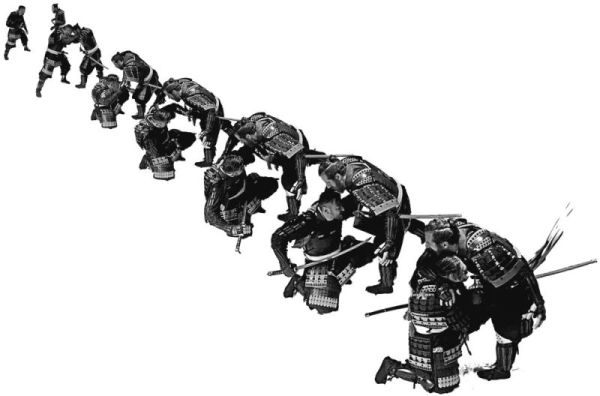
Figure 14.51.
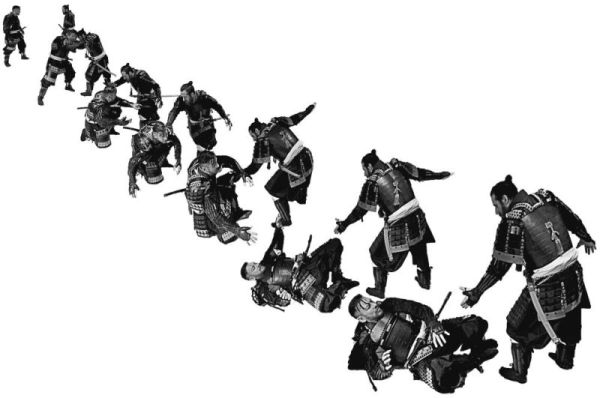
Figure 14.52.
Secret Ways of Purification and Shinobi-Jutsu (極意清浄之品 并忍術, Gokui Seijō no Shina narabini Shinobi-Jutsu)
The formal way of decorating an altar is not easy to perform. Therefore, these days we use an informal way.
To do this:
• Hang an image of your central deity50 with due respect.
• In front of the image, place a stand and put a votive light on it.
• Offer sake and washed rice [in small bowls; put them] on a thin tray.
• Place a torii gate in front of the sake and rice. The gate is one shaku eight sun [21.5 inches] in height.
• In front of that gate, place clear water in a bowl.
• Place a standing screen of six sun [7 inches] in height and eight sun [9.5 inches] in width to the side.
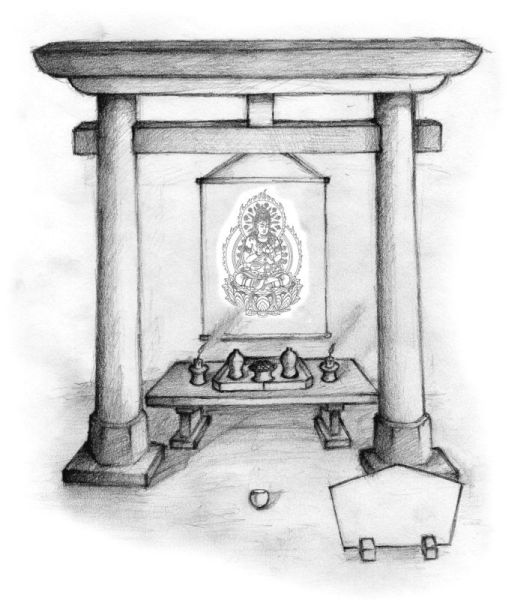
Figure 14.53.
[Method 1]
When you meditate, look at the votive light and imagine it as a great fire. Next, imagine throwing yourself into the fire. After this, put the screen at the rear of the water bowl [blocking out the fire] and think of the water in the bowl as a lake. At this point you should imagine yourself diving into the water. After doing both of these, you have purified yourself with fire and water. You have invited the Buddha—through the image—into your mind.
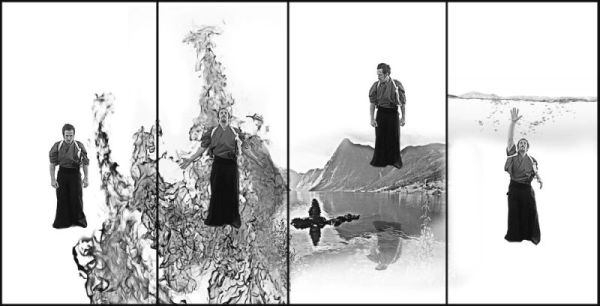
Figure 14.54.
This is the first method of three.
[Method 2]
Another method is as follows. This is called tachi haramaki (太刀腹巻). To perform this, you should draw your sword and say “On” and trace the character for fire (火) three times on the front51 of the sword, and on the reverse side you should write water (水) three times with your finger.
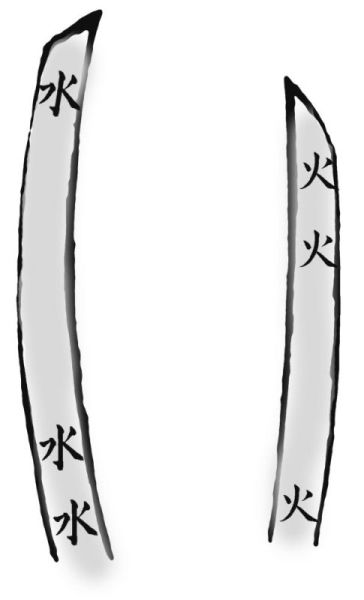
Figure 14.55.
Next, hold an image of the votive light [which is the fire] described above in your mind and stab your tachi greatsword into the imaginary flames. After this, rub the ridge52 of the sword with your left hand and observe. If you have performed this correctly, [the blade] will be flexible. If it has not been heated by the fire of your mind, however, you should repeat this meditation no matter how many times it takes. When you want to return the sword to a state before it was infused with fire, trace the character for water (水) close to the tip on the other side. Rub the ridge53 with your left hand and chant the spell below:
Sugunareya sugunaru tachi wo sugunisite yuge wo harau abiraunken
(すくなれや直なる太刀をすくにしてゆ気をはらふあびらうんけん)
The above is the second method.
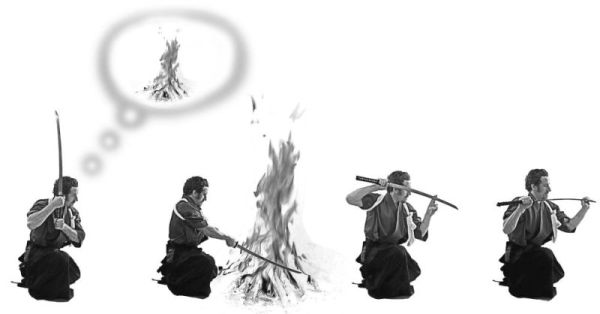
Figure 14.56.
[Method 3]
The last way is to meditate with the image described above in mind and try to picture a white fox with him. However, unless the white fox is one thousand years old, it will not work.54 This way is also applied to shinobi no hō55 to invite Inari (the god of foxes).
These are the three kinds [of purification].

Figure 14.57.
Shinobi (志のひ)
Shinobi are not those who are common. They are given orders by the lord and travel the various provinces carrying secret letters, oaths, and joint signatures.56
A Buddha statue used by shinobi for traveling around the provinces is as follows:
One way is to disguise oneself as a pilgrim and have a figurine of Hotoke hanging around the neck that has been hollowed out and made in sections with a secret letter that fits inside the statue. This is called Hotoke wari no shinobi.57
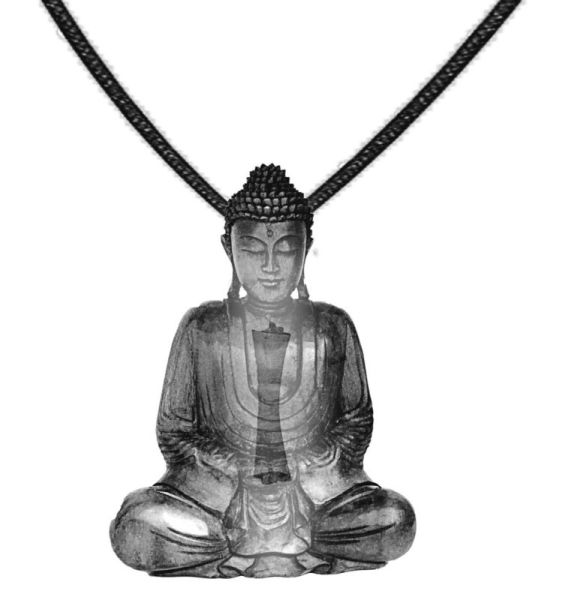
Figure 14.58.
In our school, we say that you should be extremely careful and prepare for where the enemy is likely to become suspicious and how your secret intentions can be detected. How to carry or hide a secret letter on you is described later, but if the enemy still considers you suspicious and imprisons you, you should carry a [saw] called a chinsetsu58 this is three sun [3.5 inches] in length. The manner in which you should keep it is also described later. When you are imprisoned, you should take out the chinsetsu and burn it in your mind with mental fire, just as you did with the tachi haramaki [purification spells above]. Then, saw your way out where you think you can best escape. Do this in the middle of the night so that you can move out [in stealth].

Figure 14.59.
There are things that you should keep in mind for when there is a strict policy at checkpoints. Prepare a wooden cylinder of the kiri tree of one sun, eight bu [2 inches] in length and one sun, eight bu [2 inches] in width, and then cut it into a triangular form and hollow it out. Next, cut out a heart-shaped hole, wrap [the outside] with expensive brocade, and line the inside with gold leaf,59 then meditate and put a statue of your guardian deity inside it. You should always carry this guardian deity as protection. When you come to a strictly guarded checkpoint as mentioned above you should put it under your topknot. By doing this you can hide yourself.
How to prepare a secret letter:
Fold paper in to a four-sun [4.8-inch] section, roll it into a cylinder, and secure it with glue. Keep this secret, keep this secret. This is only to be transmitted to one person. The place where you should put the secret letter is into your shitagi (under-kimono). Keep this secret, keep it secret.
To carry the chinsetsu [the saw mentioned above], you should sometimes roll it together with the secret letter described above, or alternatively you can place it between your upper gum and the upper lip. This is the deepest of secrets.
The above three secrets and shinobi-hō are mysteries from the family of Hagiwara [Jūzō] Shigetatsu, [and these were given to] Sakurai Shigenao. Sakurai Shigenao was extremely enthusiastic and he was able to obtain this. I, also being enthusiastic, was given it by him. The way of the shinobi is myriad and comprehensive. Therefore only the outline is mentioned here.
THE UPDATED WATER MIRROR SCROLL (水鏡新冊, MIZUKAGAMI SHINSATSU)
There are six points on things about your outward appearance.
1. Know that at night there should no definite method that the allied battle camp follows.
2. At night the spirit of men, be it yours or the enemy’s, will be enhanced.
3. Sometimes you will be surprised when a bow or something else that has been put against a wall falls over.60
4. [Avoid] sneezing in a battle camp.
5. If people tend to be talkative, it does not show a state of seriousness.
6. Secure the horses in your camp.
To discover the whereabouts of an ambush on a moonless night and when you can clearly see the stars, know that no stars will shine above an ambush if one is present.
One of Yoshitsune’s poems61 says:
Do not go to the direction where no stars can be seen on a pitch-dark night
While on a cloudy night, do not go toward clouds that are shining.
(闇の夜ハ星なき方に行ぬもの くもる夜ならは雲ひかる方)
Above an ambush, you will not see birds flying and there will always be energy62 present. In the morning, mist will clear sooner above an ambush. Know that chi will always hang above them.
Shinobi no mono, when trying to gain entrance to a position, will move in various guises, such as beggars. Carefully question and capture [those who are suspicious], take up their hair, or shave their heads in the correct manner,63 and put them on horseback or put them in an inner room. Also, give them bows, spears, and other weapons. Do this and observe them so that you can detect shinobi no mono.
[Shinobi] conduct their plans by disguising themselves as blind men. To do this, polish the scales of the carp fish with a fine whetstone until they are very smooth, pierce a hole in the middle of each scale, and then put them over the eyes.
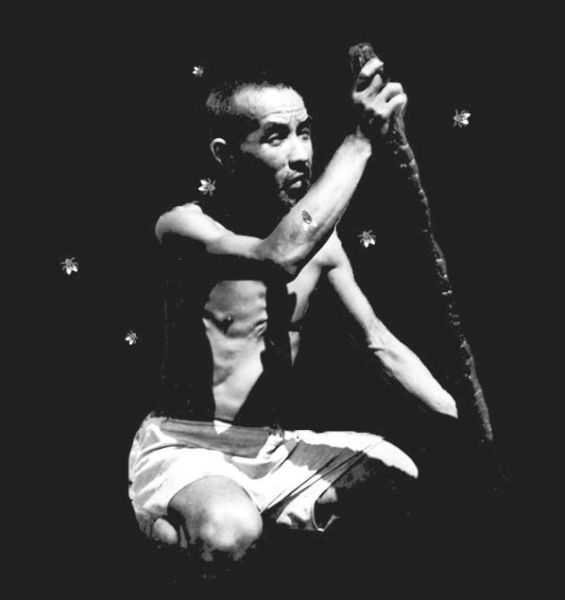
Figure 14.62.
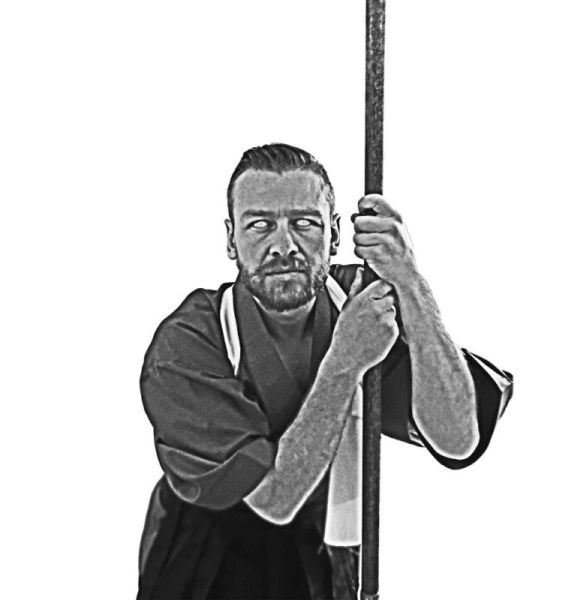
Figure 14.63.
In order to distinguish the two kinds of fire:
• human (人)
• shape-shifter (化)
Trace a cross (+) in the air with your hand in the mudra of Hō (方). Draw your sword and position it toward the fire and observe. If the target is above the hilt,64 you can say it is a light being carried by a human. If you see it below the hilt, however, it is the fire of a shape-shifter. If it is the fire of a shape-shifter,65 no matter whether it is in a mountain or a field, you should make a gesture of washing your hands, and chant the following spell three times. With this it will show its true nature:
Hintei Sowaka
(ヒンテイソワカ)
To make this peculiar fire disappear, form the mudra of Nichirin (在, zai) and chant the following:
On anichiya marishiei sowaka
(ヲンアニチヤマリシエイソワカ)
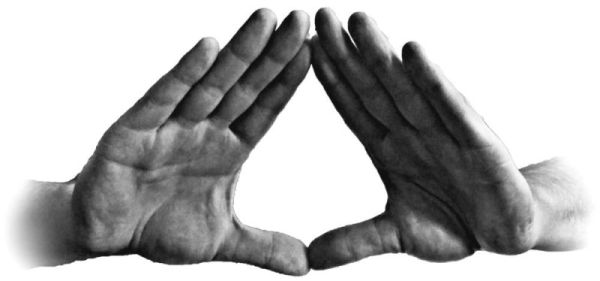
Figure 14.64.
After this, the mysterious unknown will disappear.
You should not hit something that illuminates66 with a wooden stick or cut it, because it will self-replicate [after it has been cut in half].
When you see such a mysterious creature,67 all that you need to do is to settle your mind. This point holds true not only for mysterious creatures but also for all purposes. Whenever you see people, observe them with a virtuous and clear mind. However, take note that it is difficult to identify a real-world person68 without the correct teachings. Therefore conduct goshinpō-kuji (the rite of kuji for protection) when you see these strange creatures.
There is a way to discern what is actually around. Do this by looking over the left sleeve of your kimono. The secret to making this creature show itself is that you should make the seven hand positions (mudra) of the Kōmyō Shingon so it will show what it truly is:
[The seven mudras do not appear in the original text and have been added here. The idea is to form these mudras with the hands and chant the sections underneath. Together they form the full chant.]
1. Chiken-in mudra (智拳印)
Chant: on abokya beiroshanou (オン アボキャ ベイロ シャノウ)
2. Gegoko-in mudra (外五鈷印)
Chant: maka (マカ)
3. Goshikikō-in mudra (五色光印)
Chant: bodara (ボダラ)
4. Gebaku nichūhō-in mudra (外縛二中寶印)
Chant: mani (マニ)
5. Gebaku nichū renge-in mudra (外縛二中蓮華印)
Chant: handoma (ハンドマ)
6. Chiken-in mudra (智拳印)
Chant: jinbara (ジンバラ)
7. Hachiyō-in mudra (八葉印)
Chant: harabari taya un (ハラバリ タヤ ウン)
[The full chant is: on abokya beishanou makabodaramani handoma jinbara harabaritaya un.]
A shinobi-hi is a tool that you make in the shape ▲ and of copper. It goes on top of a lantern or light so that it will go dark quickly. If you want it to become light again, take this away. How to make this tool is passed on in oral tradition.
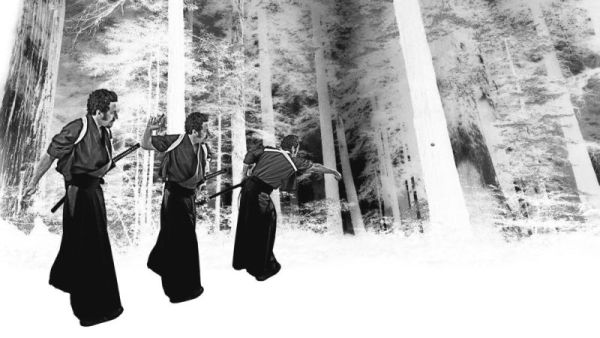
Figure 14.65.
Put tweezers over the opening [of the lantern or light] and put a one mon [copper] coin on the light. This has the same effect as the above. Also, you can put toothpicks under the lantern or light.
When you walk along a road at night and you think that it is dangerous, you should put a stone of appropriate size in your sleeve and carry it. Where you think that there is something suspicious, you can throw this stone to discover what is hidden there. Before you throw the stone, you should make a prayer to the gods and put some spit on it (fig. 14.65).
When you come across a vicious creature,69 know that they hide their toes. You should look at them carefully, as there may be difference with their legs. There are eighteen kinds of differences between human beings [and these creatures]. If you look for those points, you may find that they can move their legs in ways that a human cannot. Therefore pay attention to their legs. When you strike them, you should not cut them on the head, but strike at any lower point. The legs of a shape-shifter70 are just like a horse.71
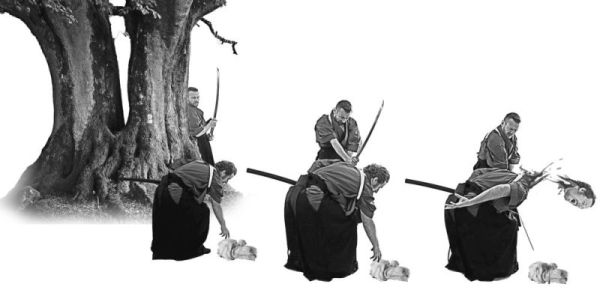
Figure 14.66.
When it is raining heavily, cloudy, and dark, you cannot see where you are going very well. Never pick up anything white or that stands out. If you pick it up, someone will strike out at you, as this white object will mark you [in the poor visibility]. If you need to pick it up for any reason, you should draw your sword out a small amount and protect yourself. Flip the white object over with your scabbard. This is done because it may poisoned; be aware of this.
Until the fourth hour,72 if you are walking in the street, walk in the middle of the road. After that time, however, move over to the left or to the right. This is because until this time of the fourth hour, the middle of the road has chi of yō.73
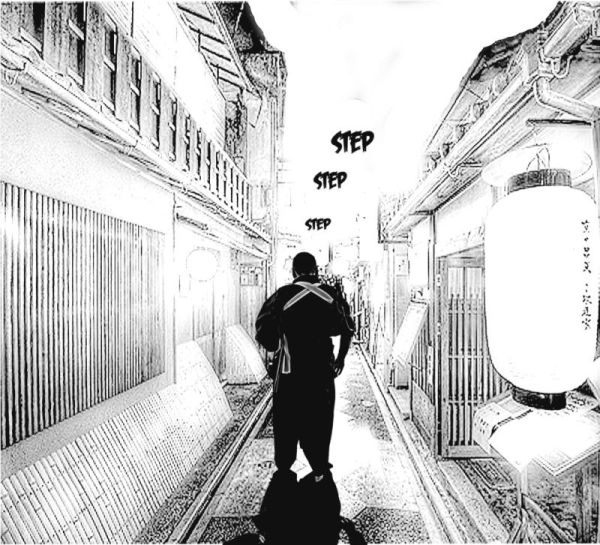
Figure 14.68.

Figure 14.69.
During the night, do not take the position with the wind or the rain blowing into your face. If you are in any argument or similar situation, move so that you are not in such a position. Even when you go out the gateway, observe the wind.
If you are in a northern province, footsteps that are not around a castle or a busy street sound out as far as one ri (2.4 miles). If someone is ahead of you, know that it can be dangerous.
After you have killed someone at night and are retreating, if you are unaware of where east, west, north, and south are and do not know what to do, find a watercourse and go upstream so that you can find a mountain. Go onto the mountain and take a position where you can observe whether people are chasing you with torches in hand. This way you can identify any roads or paths, allowing you to construct a way of escape.
If those who are chasing you are close behind and you think it is difficult to get through them successfully, cut off the end of your scabbard so that you can breathe through it, put the open end74 into your mouth, and then hide in the water. Stab your katana or wakizashi [into the riverbed] and secure yourself with this. There is a method that you must learn concerning the way to breathe for this skill, but it is passed on in oral tradition.
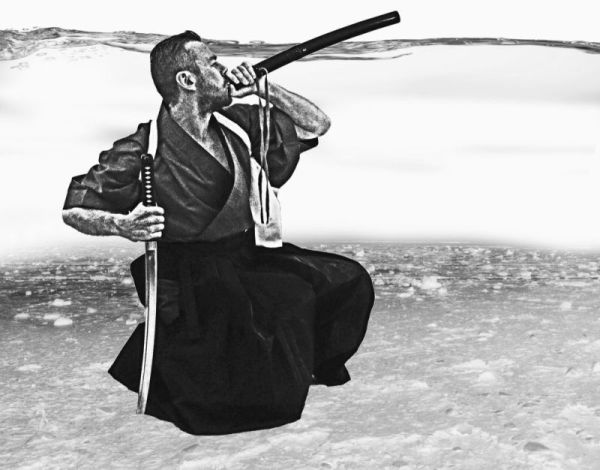
Figure 14.70.

Figure 14.71.
When you are injured on your arm or anywhere else, move into a stream of water. This is done so that people will not be able to follow the trail of blood drops.
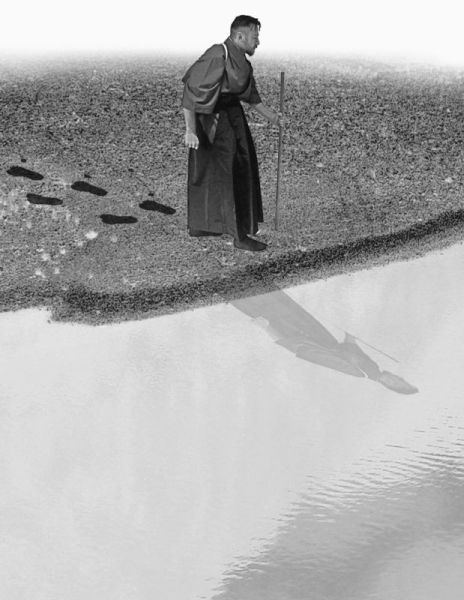
Figure 14.72.
Also, when it is snowing, you should put your footwear on backward, hold a branch75 on the left side, and move into the stream. This is done so that you are not followed.
This is an important point or spell for when you have killed someone and have to move on:76
yunde mete ato to saki towa kō no musha naru wo mamoru wa shichiyō no hoshi abiraunken
(弓手免て阿とと先とはかふの武者なるを守るは七ようのほしアヒラウンケン)
When you have someone carry a lantern for you, it is not good to have him ahead of you. Instead have him to your left side, two or three shaku [2–3 feet] behind your swords. This is done so that you have a good view of the front, the rear, the left, and the right. This is especially so when you are on guard duty and during and after the sixth month of the year.77
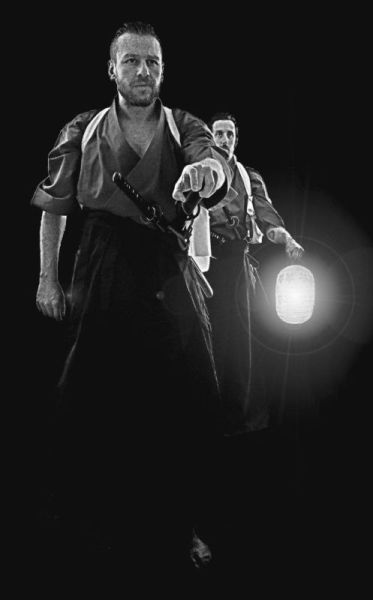
Figure 14.74.
Observe the area around the house [where you are staying] and consider what the defenses are like. You should take into account the prospect of both fire and yatō thieves.
In a house, be very careful around the floor, veranda, ceiling, and where tatami mats are soft on inspection. You should lift tatami mats and check below them thoroughly. Also, take down any decorations and hanging scrolls78 from the walls.
When you have a retainer of yours in the next room, have him sleep across the door between your rooms. If you are staying upstairs,79 have him sleep at the bottom of the steps that lead to the entrance to your room.
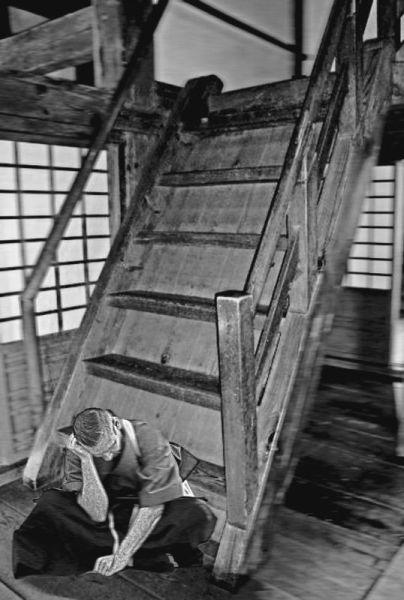
Figure 14.75.
When you are in your quarters [at a lodging], there are oral traditions for when lamps are still lit and when they have died down. They are as follows: Put both of your swords in a place that is not considered safe [while the lights are up], and after the lights have died down, move them to an appropriate and safer place. Also sleep two shaku, five sun [30 inches] away from the door.
Any pillow you use should be one that will not let you sleep comfortably. Also, there is something called the pillow of crickets. With this you will wake up even if a cricket comes into your house. This is an oral tradition.
How to construct the pillow of crickets:
Cut paper in a square and write down these words as shown (fig. 14.76). The characters to use are listed here:
1. 蘇民 (somin)
2. 無昇 (mushō)
3. 通達 (tsūtatsu)
4. 太刀 (tachi)
5. 犬 (inu)
6. Draw the arrow [and follow the instruction below].
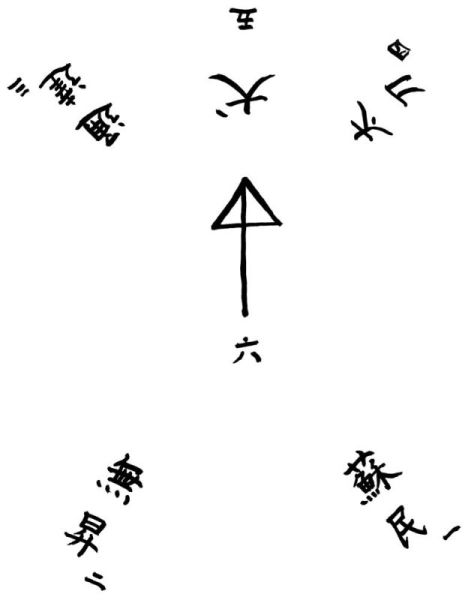
Figure 14.76.
When you write the arrow,80 create a meditative image. For the vertical line, hold the image of piercing a dog.81 While drawing this line, [chant] “on marishiei [sowaka].”
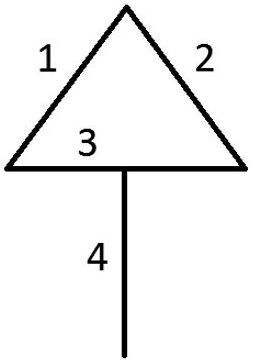
Figure 14.77.
Write the above on hōsho paper, then cut tatō paper into a square and seal [the talisman] within the tatō sheet. When you sleep, lay with your head on it. Whenever you are worried in a traveling lodge or similar situation, use this [and you will wake if danger approaches]. If you do not have it with you, write [this spell] in the four corners of the room.82 More is found in oral tradition.
When the enemy infiltrates and there is a moat, river, or pond in the area, he may have prepared an appropriate size stone beside the water. This is done for the case that if the people of the house wake up and the shinobi is chased, he may throw this stone into water. If you are not aware of this technique, you will be deceived.83
Sometimes the person who has infiltrated, if he thinks he has been detected, may keep a level head and step into the hearth and crouch there, trying to take advantage of any gap you show, and will strike and escape. The oral tradition here is that anyone who wakes up will be very familiar with the house, and will automatically avoid this place. Be aware that an infiltrator may wait here and attack those who come close by the fireplace who are trying to get a light.
When you exit to chase an enemy who has infiltrated, there are things you should be aware of, including the following. Oral tradition states that you should be careful about everything. When an enemy has infiltrated, stretch a cord across the entrance, and if there is cloth curtain, you should cut it vertically and leave four or five sun [5–6 inches] at the bottom [uncut, so that when he exits, he will become trapped inside it]. If it is a screen of rope, you should tie the ends together at the bottom. If there are stairs, he will hide in the next room, and if someone comes down the stairs, he will attack from that position. Be aware of this. If the enemy is chased suddenly, he will scatter caltrops behind him on his way out, and if you step on them, you cannot proceed any farther. When the enemy goes out through a gate, he will shut it, and that will allow him to go five ken [100 feet] farther while you are still trying to open it. There are teachings on chasing or escaping, all of which are skills to be orally transmitted.
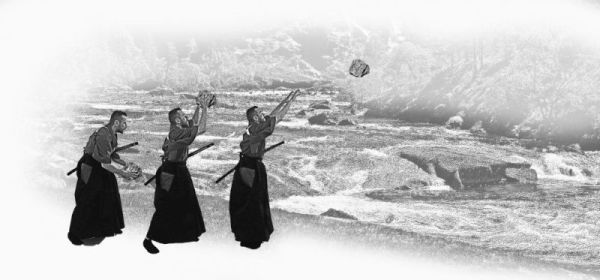
Figure 14.78.
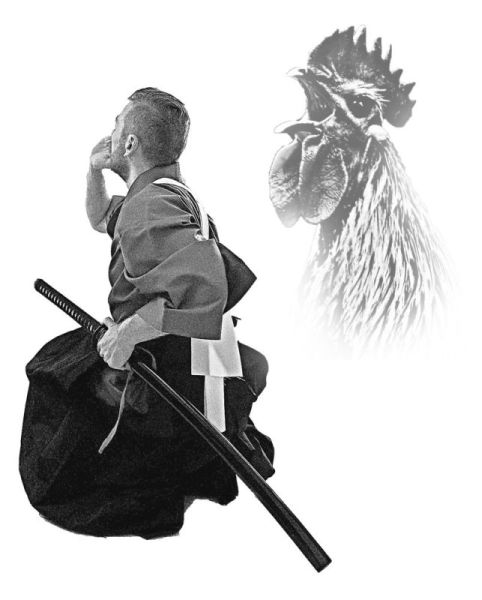
Figure 14.79.

Figure 14.80.
When you perform as a shinobi, you should learn to imitate birds and other such things, as it is often useful when you are undertaking shinobi action. In ancient China there was a case where the guards at a checkpoint allowed [Tian Wen] to go through, because one of his men made the sound of a cockerel. You should copy a cockerel particularly on a kōshin night. Some people say whatever you do on a kōshin night will be exposed without fail. This was first said by thieves. Are these things detected with ease or not on this night? As to which is correct is an oral tradition.
To know if there will be an accident on a ship, before you get on board, write the character below on the ground with your big toe, and when you write the final dot, step on it and then look at the captain’s face. If there is to be a problem [with the ship], you will see him headless. However, if there is nothing to worry about, then you will see him as normal.
To prevent seasickness [for others], you should pray to [Prince] Yamato Takeru, write the character below toward the deck84 of the ship, and put the last dot on the head of the person [who is seasick].
賦
Alternatively, you can get on board with a straw hat and carry Pinellia tuber. If it is not available, you should scrape and take the clay from a wall [and take that]. Carrying sulfur in your kimono will also suffice. In addition to this, you can prepare twisted paper string and tickle the inside your nose to sneeze before you get on board. Those who shoot muskets do not get seasick.
If you have an engraving of Kurikara Fudō (a dragon wreathed in flame) on your ko-gatana knife, then also you will not suffer from seasickness. Ko-gatana and a kozuka [small blades attached to a sword scabbard] will protect you from being attacked in vengeance [while traveling], but this does not always hold true with any vehicle.85
If you come across mountain bandits, keep your mind calm and pass through as quickly as possible without becoming scared. While traveling for two or three ri (5–7 miles) from that point, keep a watchful eye for anyone coming from the front, rear, right, or left. Mountain bandits are usually in a group of six from the servant class.86 Know that only one will show himself at first, while the other five or so will be hiding in a grass field or somewhere of that nature.
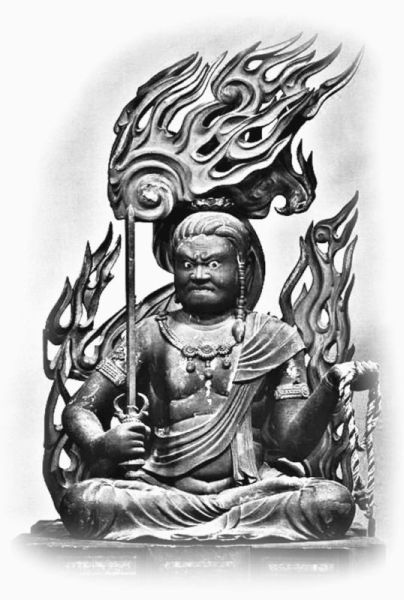
Figure 14.81. Kurikara Fudō
Oral tradition states: mountain bandits will put their left ear to the ground to know [if someone] is strong or weak [by the strength of their footsteps] and also to listen to their voices [to see if they have strong personalities]. Those who are decisive and with a righteous mind, who have a resonant and clear voice, have a strong mind and maintain a tight belly when on a mountain or in a field. When scared, you cannot maintain such a tight belly, and your voice and footsteps will sound hollow, clench your teeth, maintain a tight belly, and shake the ground with your steps. Also, when scared on a mountain or in a field, chant the spell of Fudō no Jiku no Ju; this will give you a strong mind. Those whose footsteps continue to resonate are brave and strong, while those who are weak have light footsteps. It is said that mountain bandits decide if they will fight after they have identified the type of footstep [of their intended target]. Also, they may stretch rope across a road. There is an oral tradition for this case.
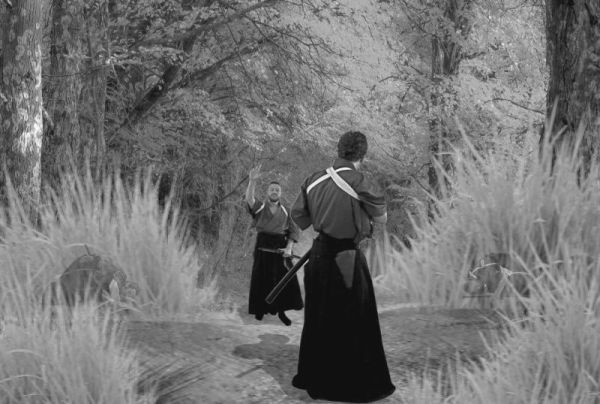
Figure 14.82.
If there is a sick person on the road while you travel, who is moaning in pain, asking you for medicine, you should be aware that you should not get close to such a person. Also, if someone you do not know wishes to accompany you in the daytime, then this is also not a safe situation.
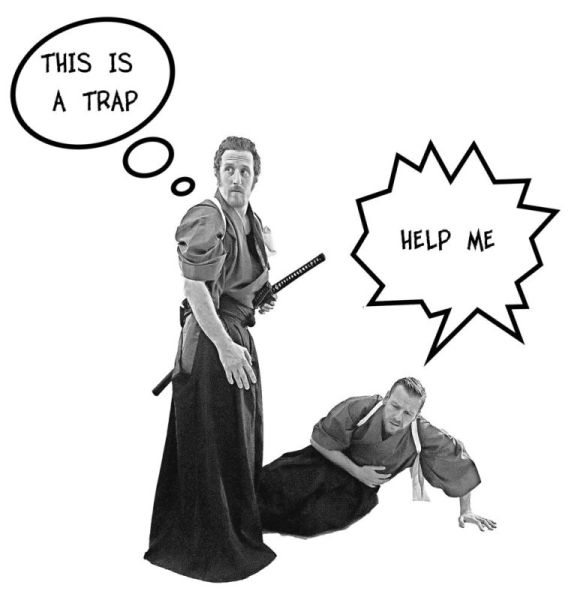
Figure 14.83.
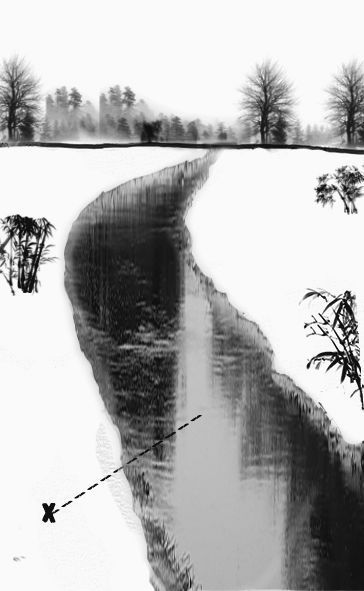
Figure 14.84.
When you cross over a river you are not familiar with, you should move diagonally upstream [then move downstream when half way across].
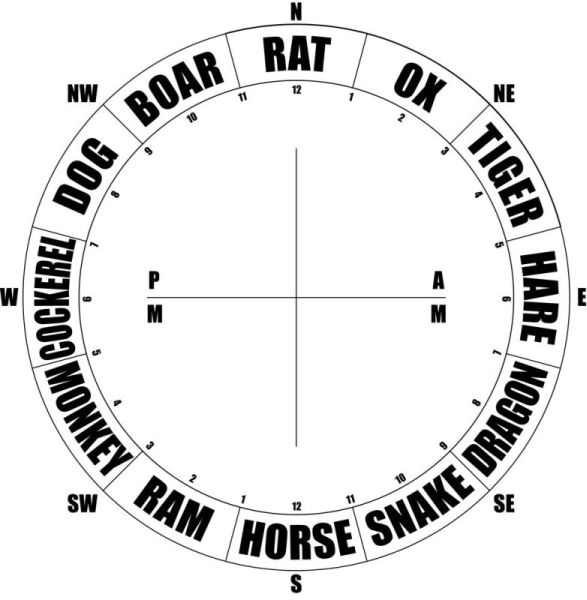
Figure 14.85.
How to know from which direction tōzoku thieves will come from:
On the days of the:
• Rat
• Horse
• Cockerel
• Snake
• Boar
• Tiger
Thieves will come from the eighth direction from the animal for that day.
On the days of the:
• Ox
• Ram
• Dog
• Hare
• Monkey
• Dragon
Thieves will come from the fourth direction for the animal of that day.
You can identify the direction according to the Twelve Earthly Branches.87
On a day of Kinoe and Kinoto they will come in the hour of the Dog.
On a day of Hinoe and Kanoe they will come in the hour of the Rat, Tiger, Dog, or Boar.
On a day of Tsuchinoe or Kanoto they will come in the hour of the Rat or the Dog.
On a day of Tsuchinoto and Mizunoe they will come in the hour of the Horse and the Boar.
On the day of Mizunoto and Hinoto they will come in the hour of the Rat.
When you wake up [unexpectedly] while in a traveling lodge or your own house, the things you should pay attention to are:
• if rats are making noise
• if mosquitoes are flying about quickly
• if insects are making noises
If you are in your house, you should check the external areas. There are oral traditions here.
Here is a hint you should be aware of when while you are engaged in duty [around a castle, etc.]: If a retainer or somebody loses his mind, you should bind him inside of his kimono and carry him out as if he is ill. Have his body bound in the kimono and bind his legs [around the height] of one shaku [1 foot], then carry him away.
When someone is bitten by a horse, put water into a wooden trough or a ladle and write the characters 離火消水 with the Two Swords hand mudra,88 have the person bitten drink three sips, little by little, and pour the rest of the water on to the wound. Also, you can chew raw millet and put the pulp on the wound; this will also work.
When you are stung by a bee, grind the leaf of the taro plant and put it on the sting; this will help. Also, you can write the following on the sting:
南無赤不動明王
(namu aka fudōmyō’ō)

Figure 14.86.
Hayatsukegi (fast fire tool): either put sulfur on both ends [of a taper], or put equal amounts of a decoction of sulfur and camphor on thick paper.
Do not run out of breath smoothing medicine. You should always have, be prepared with, and be aware of the following way: take a blue hand cloth, cut a bundle of straw of the thickness that you can grip, [wrap it with the cloth], and then put it across the mouth.89
The art of the shape-shifter at night (夜中妖怪ノ事, yachū yōkai no koto)
This concerns an army at night and is the skill in which shinobi no mono disguise themselves as women. Normally there is nothing particularly dubious about them, but there are oral traditions about this. In this case, if you burn pine resin or cedar resin, this skill will disappear.90
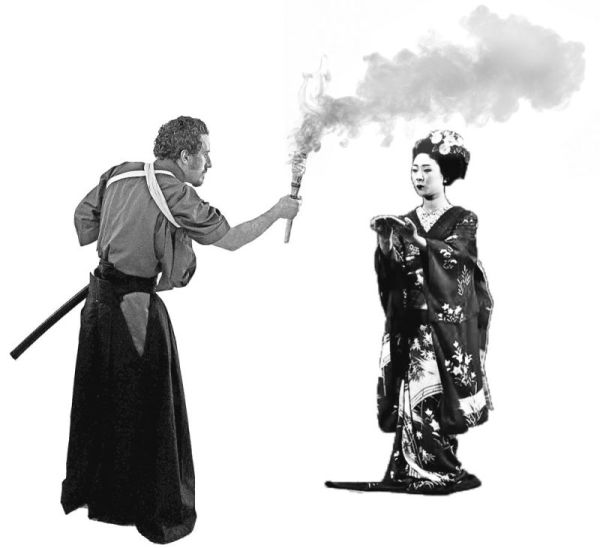
Figure 14.87.
If you happen to fight a vicious creature91 at a malignant place, you should pick up a stone and chant the name of your god, or say “Yun Hotoke, Yun Kami,”92 put your spittle on the stone, and throw it to hit this creature. At this point, a wooden statue and the like may appear by magic. You also should hit this [with the stone]. In Iga, Kai, and Nagato,93 they perform this tradition.
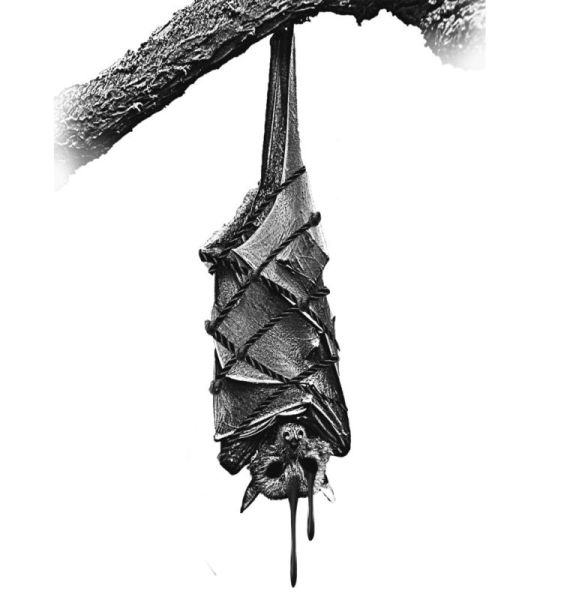
Figure 14.88.
How to prevent mosquitoes from coming into the room: Write the characters for wind (風) and smoke (煙) on paper and put it under the window. Capture a brown bat94 and bind it upside down in the east of a room, take its blood, and soak cord in this blood. Stretch the rope at the height of sleeping level. This tradition is called Yoshitsune’s Principle of Sleeping Quarters (Yoshitsune neya no daiji).

Figure 14.89.
How to not shake and shiver from illness: During the three months of spring, grind the flowers of a hemp plant and put it [in] your nose. Also, you can put the juice of the hemp leaves into a bowl, add some water, and mix them. Also, have the morning sunshine reflect on the water and drink it; this will free you from shakes and shivers for one year.
How to stop a baby crying in the night: Stretch a rope that has been soaked with the blood of a gray horse on the roof. Then a talisman should be written as follows:
You should write the talisman (shown in fig. 14.89) on blue paper and make one end to look like a [Chinese] sword. You should put this talisman in [or around] a stove.
A teaching about departure from a poem by Yoshitsune says:
If you find a rice husk in your departing meal, it is a sign of luck for your upcoming conflict.95
(門出ニスハリシ食ニモミアラハ 仕合ノヨキスイソウトシレ)
If you hear a crow calling upon your departure, if it is an odd number, it is lucky; if an even number, however, then you should be careful. Also, it is unlucky if an animal crosses your path. When you depart, you should start with the leg of yō (the left leg).
Use an ink stone and rub the ink stone in the ink tray [to create the ink]. When you do this, mix your earwax in the ink. When you go to a battle camp, you should put an ear pick in your ink set.96 This is the proper way. If you write something for an important matter, mix grated yam in the ink. Alternatively, you can apply [the grated yam] to the writing afterward. This will dispel yōkai (monsters), and they will have no power. Also, you can add grated yam, and the writing will not come off.
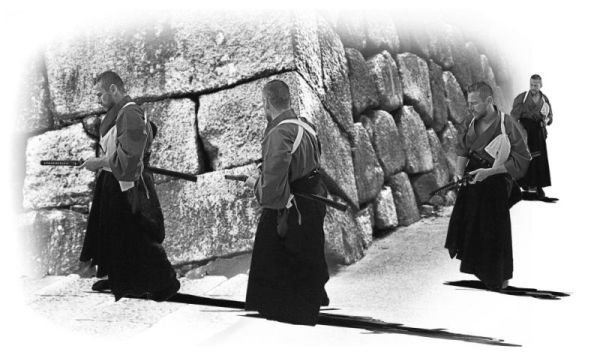
Figure 14.90.
When you approach a corner of a street, you should observe both the left and the right and pass the corner carefully, as it is not good to turn a corner carelessly.
The principle of birds (鳥類之大事, chōrui no daiji)
In a period of war, how to observe birds that fly away or approach is as follows:
• If the birds are chirping and facing your direction, it is lucky.
• If you are hit with bird droppings, it is bad luck.
• If a bird comes in your room, even if it is a simple hut, it is unlucky.
• If a crane makes a nest [around the house], it is unlucky.
• It is unlucky if [you see] birds flock together.
• It is unlucky if birds make much noise at night.
• If birds chirp in the early hours of the night, they may be made to chirp through shinobi no hō (the ways of the shinobi).97
There are more details to be passed orally.
This scroll consists of seventy-five points98 concerning shinobi, which should be constantly kept in mind. However, [we are] not exclusively on that path. If there is a very strong enemy who cannot be defeated, and you intend to perform a night attack upon him and alone, you should attack with these skills. If you are determined to die when you attack with these skills, no matter how strong the enemy is, there is no chance that you cannot fulfill your aim. These lessons should not be given out, and it is strictly forbidden to use the above teachings for an unrighteous purpose. This is to be acknowledged beforehand with a written oath. Therefore, there is no need to dwell on this anymore. However, if you give it away without permission, you cannot escape the punishment of the gods, as it has been written in an oath.
This scroll is a secret writing that has been transmitted in our family; however, as you are enthusiastic to have this writing, I will give all of this to you. Do not expose this to others.
Let it be so.
The first month of Kōka 2 [1845], a Year of the Snake

Figure 14.91.
